#hawaii endemic birds
Text
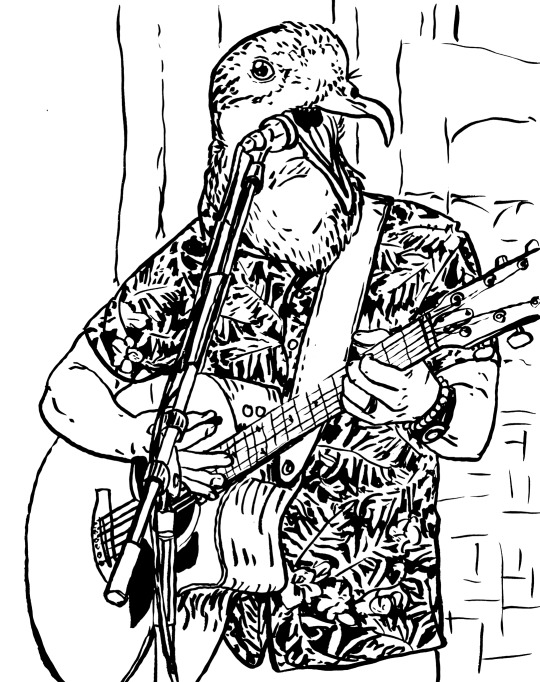
The Lahaina wildfire is now the deadliest in US history in more than a century and the worst recorded natural disaster to hit the Hawaiian islands.
Invoice PDX is going to be accepting art donations to put up for auction, with funds going directly to people in need in Maui.
Message them to get involved and follow them for updates.
This ‘ua’a - or Hawaiian petrel - along with three other illustrations featuring the likenesses of birds endemic to Hawaii will be finished with watercolor and made available for the auction mentioned above.
#maui strong#signal boost#art auction#disaster relief#‘ua’a#Hawaii#Hawaiian petrel#furry art#anthro art#direct aid#invoice pdx#invoicepdx#Lahaina#wildfire#wildfires#artists on tumblr#illustration#Maui
18 notes
·
View notes
Photo
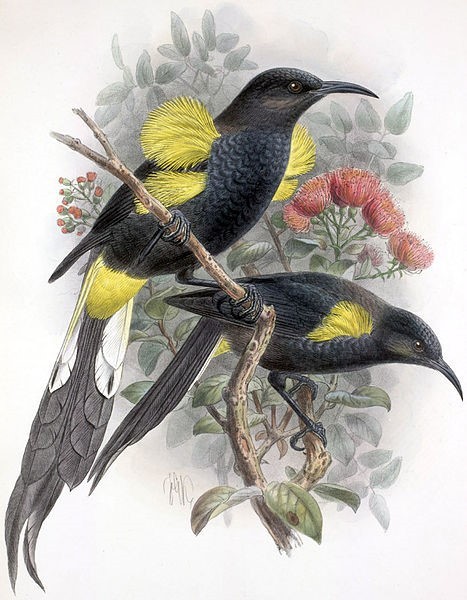
youtube
Hawaii O’o †
Moho nobilis. Extinct. Formerly endemic to the Big Island of Hawaii.
Hear the song of the last Kauai O'o bird and learn more about what is causing mass extinction...
https://birdfinding.info/hawaii-oo/
28 notes
·
View notes
Text

'O'mao (Hawai'ian Thrush)
These robin-like birds are the Hawai‘i Island's last native fruit-eating bird that still lives in the wild and plays an important role in re-establishing native understory plants such as ‘olapa, ‘ohelo, and akala, spreading seeds after they pass through the bird's digestive tract.
#Hawai'ian Birds#Birds#'O'mao#Hawai'ian Thrush#thrush#animals#wildlife#nature#ecology#wildlife conservation
41 notes
·
View notes
Text
Bird of the Day Megapost
Welcome to the blog! Here, I post every day a couple of facts about a species of bird. If you'd like to learn more about our feathered friends, please enjoy your stay!
In this post: FAQ, Hashtags/trigger warnings list
FAQ
Q. Why did you start this blog?
A. My biggest special interest has been birds my entire life. By running this blog, not only do I get to share my passion with others, but I also learn new things myself!
Q. One of the facts you posted is incorrect! Why?
A. I get the majority of my facts from Wikipedia, but also source other websites or even bird books I own in real life. Sometimes the information from these sources may be outdated, or even just incorrect. I sincerely apologise for any of these incorrect facts, so feel free to correct me in the tags. I do not use facts I simply remember, or have from my own experience, since my memory is poor and admittedly I have quite limited knowledge on birds myself, so it would be rather unreliable.
Q. Can I suggest a bird of the day?
A. Of course you can! Feel free to suggest bird species or bird facts in the ask box! For the purposes of keeping the blog clean, I will not directly answer these asks, but rest assured I am seeing them and working on adding them to the queue!
HASHTAGS
Warning hashtags:
#bird extinction tw - used when the post contains mention of birds going extinct or very endangered
#prey item tw - used when the image in the post contains a prey item such as another bird or a mammal, and could be considered graphic
#birds as prey tw - similar to prey item tw, used when the post contains or mentions birds being eaten as prey by other birds or animals
#insects mention and similar - used when the post mentions insects
#bird abuse tw - used when the post mentions abuse or mistreatment of birds, such as illegal trapping
#religion tw - used for mention of religion
#birds as food tw - used when the post contains mentions of birds being eaten or used as food
Post type hashtags:
#tropical birds - used for birds that are not found in the United Kingdom (I am aware I am not using the world tropical correctly)
#weird and wonderful - strange, weird, or unusual birds/bird facts
#bird record holders - birds who hold world records
#endemic birds - birds that are endemic to one specific place
#other's facts - reblogs/replies to facts other people have added in response to my posts!
#pigeons and doves
#herons and egrets
#birds of prey / bird of prey
#wading birds #water birds
#ducks #waterfowl
#corvids
#parrots
Location hashtags:
#british birds, #birds of the uk and ireland and similar
#birds of australia
#birds of africa
#birds of mexico
#birds of hawaii #birds of hawai'i
#galapagos islands
#birds of new zealand
#birds of america #birds of north america #birds of south america
#birds of europe
More to come
Thank you for checking out my blog! <3 <3 <3
9 notes
·
View notes
Text

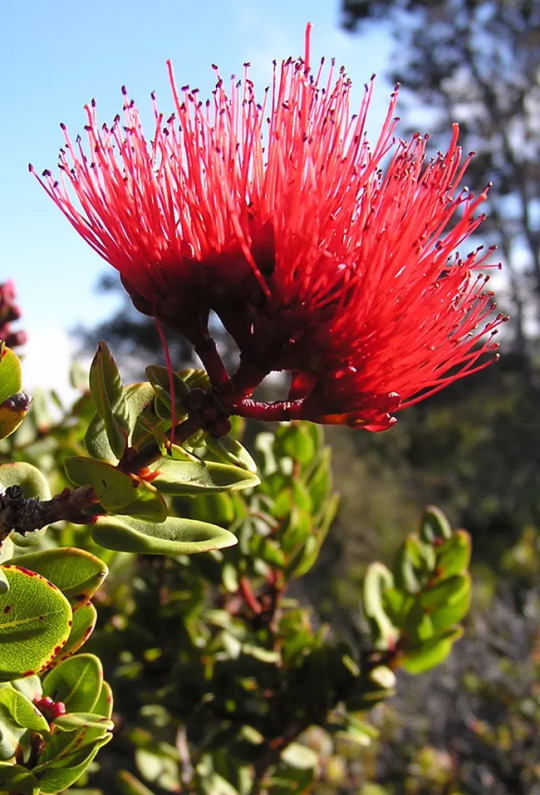






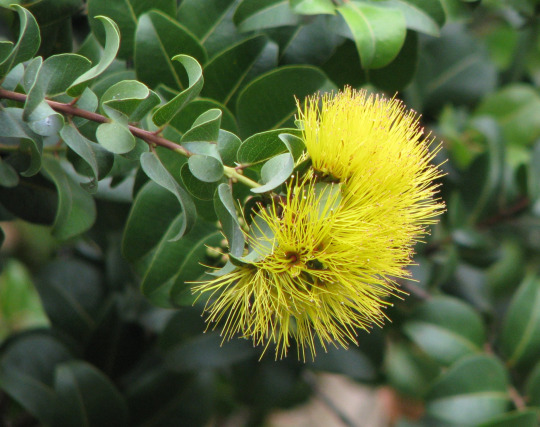
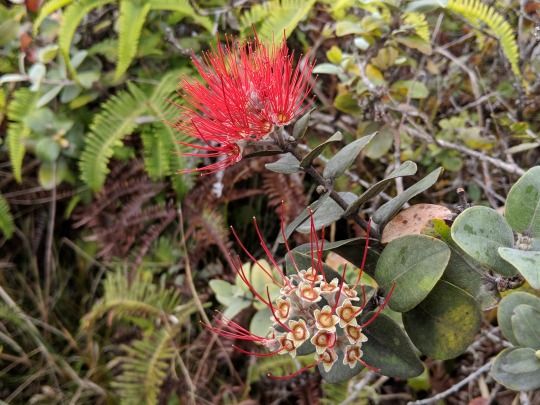
‘ōhi‘a lehua: Metrosideros polymorpha, can be a shrub or tree with red, pink, yellow, or white flowers; the flower of Hawai‘i Island
20–25 m (66–82 ft) tall in favorable situations, and a much smaller prostrate shrub when growing in boggy soils or directly on basalt. Many native Hawaiian traditions refer to the tree and the forests it forms as sacred to Pele, the volcano goddess, and to Laka, the goddess of hula. ʻŌhiʻa trees grow easily on lava, and are usually the first plants to grow on new lava flows.
The most common native tree in the Hawaiian Islands, tolerating a wide range of soil conditions, temperature, and rainfall. It grows from sea level right up to the tree line at elevations of 2,500 m (8,200 ft) and is commonly found in moist and dry forests, high shrublands, and is a colonizer of recent lava flows. It is relatively slow growing. Dominant in cloud forests above 400 m (1,300 ft), the tree is also common in seasonally wet forests, where it may be dominant or form mixtures with the native Acacia koa.
The trunk varies in form. In some trees, it is straight and smooth; in others, it is twisted and prominently fluted. Trees growing in forests often have stilt roots, having germinated on logs or the stems of fallen Cibotium tree ferns, which have long decayed away when the tree has reached maturity. Some trees have fibrous aerial roots to gather moisture. At high elevations, and in areas with poor soils or little rainfall, shrub forms are the norm. Flowers are usually bright to medium red but orange-red, salmon, pink, yellow, or orange forms are also found.
ʻŌhiʻa lehua is one of the few honey plants that is native to the Hawaiian Islands.
In Hawaiian mythology, ʻŌhiʻa and Lehua were two young lovers. The volcano goddess Pele fell in love with the handsome ʻŌhiʻa and approached him, but he turned down her advances. In a fit of jealousy, Pele transformed ʻŌhiʻa into a tree. Lehua was devastated by this transformation and out of pity the other gods turned her into a flower and placed her upon the ʻōhiʻa tree. Other versions say that Pele felt remorseful but was unable to reverse the change, so she turned Lehua into a flower herself. It is said that when a lehua flower is plucked from an ʻōhiʻa tree, the sky will fill with rain representing the separated lovers' tears. (Source.)
Since ʻōhiʻa are nearly in constant bloom, they attract numerous bees and other insects.
Early Hawaiians had many uses for ʻōhiʻa. The exceptionally hard wood was fashioned into kapa beaters, prepping boards for kapa, poi boards, musical instruments, dancing sticks, idols, spears, daggers, clubs, mallets, standards of kāhili, house construction, gunwales and interior framework for canoes.
From early Hawaii to the present day, flowers, seed capsules and new leaves have been used for lei working. Lei ʻōhiʻa, with or without other material, were given names such as lei lehua ʻula (red flowers), lei lehua ʻalani (orange flowers), lei lehua melemele (yellow flowers), and lei liko lehua, made with new leaves. (Source.)
‘Ōhi‘a lehua is endemic to the six largest islands of Hawai’i and is the most common native Hawaiian tree, comprising 80% of Hawaii’s native forests. Leaves of this tree sustained populations of native birds, such as the apapane and the mamo, whose vibrant feathers were used in traditional Hawaiian clothing and ceremonial adornments. Play a key role in watershed protection and water conservation by retaining water following storm events and preventing subsequent erosion and flooding. (Source.)
1 note
·
View note
Text
Listen to the Last Song of The Extinct Kauaʻi ʻōʻō
Hawaii, like many tropical islands, is home to many endemic species, ones found no where else on Earth.
The Kauaʻi ʻōʻō was one of those, a beautiful small bird with an exquisite birdsong that feels almost magical.
The Kauaʻi ʻōʻō was a part of the Mohoidae family, a group entirely unique to the Hawaiian Islands. With its striking plumage of rich, velvety black feathers and a bright yellow…
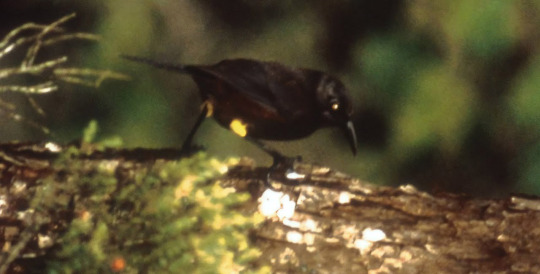
View On WordPress
0 notes
Text
Nature's Wonders: Exploring Animals That Start With 'N’
The natural world is filled with a diverse array of creatures, each with its own unique characteristics and contributions to the delicate balance of ecosystems. In this exploration, we turn our attention to the animals that start with n and discover a captivating collection of animals that start with this letter. From the depths of the ocean to the heights of the rainforests, let's delve into the lives of these fascinating creatures.
Narwhal
Kicking off our list is the narwhal, often referred to as the "unicorns of the sea." These intriguing marine mammals are known for their long, spiral tusks that can reach lengths of up to 10 feet. Found primarily in the Arctic waters, narwhals use their tusks for various purposes, including hunting for food and navigating through icy waters.
Newt
Venturing onto land, we encounter the newt. These small amphibians are well-known for their bright colours and unique skin texture. Newts go through a fascinating life cycle, starting as aquatic larvae before transforming into terrestrial adults. Their vibrant appearance serves as a warning to predators that they possess toxic skin secretions.
Nightingale
As the sun sets and darkness falls, the nightingale takes centre stage with its melodious and enchanting song. This small songbird is celebrated for its powerful and varied vocalisations, often associated with warm summer nights and poetic inspiration. Nightingales can be found in Europe, Asia, and Africa.
Numbat
Hailing from the Australian outback, the numbat is a striking marsupial with distinctive reddish-brown fur adorned with white stripes. This unique creature primarily feeds on termites, using its long tongue to extract the insects from their nests. The numbat's natural habitat is threatened, making it a symbol of conservation efforts in Australia.
Nudibranch
Diving into the ocean's depths, we encounter the mesmerising nudibranch. These colourful and often flamboyantly patterned marine gastropods are a wonder to behold. With their vibrant hues and intricate shapes, nudibranchs demonstrate the diversity of life beneath the waves.
Nile Crocodile
One of the apex predators of Africa's waterways, the Nile crocodile demands respect and awe. With its powerful jaws, armoured body, and exceptional hunting skills, this reptile is a symbol of both danger and the complex ecosystems it inhabits.
Nene
Endemic to the Hawaiian Islands, the nene is the state bird of Hawaii and a symbol of the islands' unique wildlife. Also known as the Hawaiian goose, the nene has managed to survive and recover from the brink of extinction, thanks to conservation efforts. Its name comes from its distinct "nay-nay" call.
Nutria
Originally native to South America, the nutria, also known as coypu, has established itself in various parts of the world due to human introductions. These semi-aquatic rodents are known for their webbed feet and coarse fur. While considered pests in some areas, they play a role in wetland ecosystems.
Conclusion
From the depths of the oceans to the vast landscapes of various continents, animals that start with the letter 'N' bring a sense of wonder and appreciation for the diversity of life on Earth. Each of these creatures, with their unique adaptations and roles, contributes to the intricate web of life that sustains our planet's ecosystems. As we continue to explore and learn about these remarkable animals, we deepen our connection to the natural world and our responsibility to protect and preserve it for future generations.
0 notes
Text
Birds And Their Eggs
There are so many different types of birds: Waterfowl (Anseriformes), Birds of Prey (Accipitriformes), Hummingbirds (Apodiformes), Nightjars (Caprimulgiformes)... The list goes on and on! But have you ever wondered what their eggs look like?
Let's explore the types of birds and their eggs.

How to identify birds' eggs
Identifying bird’s eggs can be tricky, even for experienced birders. But with a bit of practice, you'll be able to tell the difference between the eggs of many birds.
The first step in identifying a bird's egg is determining its size. Bird eggs come in all different sizes, from tiny hummingbird eggs to huge ostrich eggs. Take a look at the color, Bird eggs can be white, blue, green, brown, or any combination of these colors. Finally, there are usually markings. Some eggs have spots, while others have different markings.
That's probably the basics of identifying eggs. And now let's know more about the birds and their eggs.

Great tit
The great tit is a recognizable bird with a black head and neck, prominent white cheeks, olive upperparts, and yellow underparts. In the summer, it mainly eats insects. In the winter, it will consume a wider variety of foods, including little bats that are hibernating.
Great tit eggs measure 17.5 x 13.5mm and have a slight sheen. They have varying degrees of reddish or purplish speckling over their white background.

Starling
In addition to northern Australia and the islands of the tropical Pacific, starlings are endemic to Europe, Asia, and Africa. Many species from Europe and Asia have been imported to these regions, as well as to North America, Hawaii, and New Zealand. They are regarded as invasive species because they frequently compete with native birds for habitat. The common starling is the species most people in Europe and North America are familiar with.
Starlings are exceedingly sociable, with powerful feet, and a strong, direct flight. They eat insects and fruit and enjoy an open, rural environment for their habitat. Many creatures that dwell close to human settlements are essentially omnivores.
Sized at 30 x 21 mm, starling eggshells are smooth and relatively glossy. They are typically pale blue-green bird eggs.
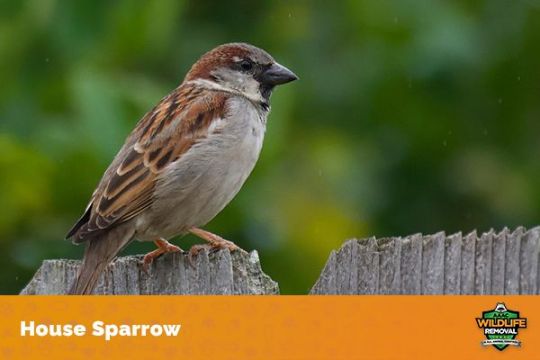
House sparrow
Male house sparrows have more vivid black, white, and brown markings whereas females and young birds are colored a light brown and grey. Native to much of Asia, the Mediterranean region, and most of Europe. It is the most extensively dispersed wild bird due to its deliberate or unintentional imports to numerous areas, including sections of Australasia, Africa, and the Americas.
The house sparrow, which can be found in both urban and rural areas, is closely related to human habitation. Although it can be found in a broad variety of habitats and climates, it normally stays away from vast woodlands, meadows, and deserts that are not well developed by humans. Although it is an opportunistic eater and frequently consumes insects and a variety of other things, it primarily consumes the seeds of weeds and grains.
House sparrow hatching eggs are slightly glossy, 22.5 x 15.5 mm eggs. White with variable amounts of dark brown and blue-grey speckling.
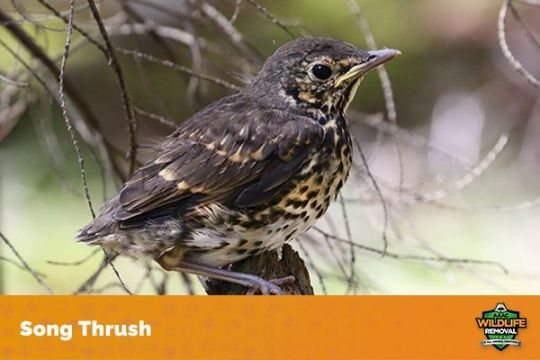
Song thrush
The song thrush is a migratory species with brown top parts and cream or buff underparts with black spots. The song thrush nests in forests, gardens, and parks. Even though it is not in danger internationally, there have been significant population losses in some regions of Europe, probably as a result of modifications to farming methods.
A whole egg from song thrushes is 31 x 22 mm in size, smooth and lustrous. They are light blue eggs with a few noticeable, sizable dark specks, mainly at the wide end.

Hummingbird
The tropics are where the vast majority of Hummingbird species are found. They are little birds, with the majority of species measuring between 7.5 and 13 cm. The bee hummingbird, which measures 5 cm and weighs less than 2.0 g, is the smallest species of hummingbird still living (0.07 oz). The 23 cm enormous hummingbird, which weighs 18-24 grams, is the largest species of hummingbird. Although all species eat flying insects or spiders, they are adapted for feeding on flower nectar.
Hummingbird eggs are white and elliptical and are small eggs about the size of a small jelly bean. Most are less than a gram or the weight of a paperclip!
Blackbird
Depending on latitude, the blackbird can be resident, partially, or fully migratory. Located throughout most of Europe, it has a rich, musical singing voice. It is primarily black or dark, dark brown with yellow eyes beak. The adult female and juvenile have mostly dark brown feathers. This species builds a tidy, cup-shaped nest tied together with mud to reproduce in gardens and woods.
Blackbird eggs are pretty striking. The size of three centimeters, green, blue in color, and covered in brown dots.
Robin

The European Robin
A tiny insectivorous bird also referred to as the robin or the robin redbreast in the British Isles. The male and female are similar in color, measuring around 12.5-14.0 cm in length, with an orange breast and face bordered with grey and brown middle parts and a creamy belly. It is widespread throughout Europe, extends east to Western Siberia, and south to North Africa. They tend not to migrate, but a subset of robins do move around based on the season and latitude of their habitat.
The eggs are cream, or white with reddish-brown spots, which are frequently more prominent at the larger hemisphere of the egg.
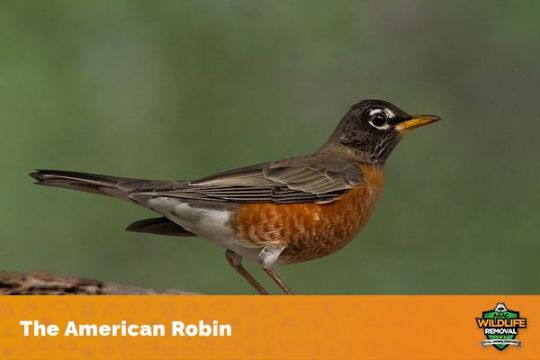
The American robin
A songbird that migrates. Although the two species are not closely related and the European robin is a member of the Old World flycatcher family, it was named after the European robin because of its reddish-orange breast. The American robin can be found all over North America; it winters along the Pacific Coast, in southern Canada, and in central Mexico. It is the national bird of Wisconsin, Michigan, and Connecticut.
The pigment biliverdin is responsible for the blue color of robin eggs when the eggs hatch. There is evnidence that more blue the eggs appear and the healthier the female are associated with elevated biliverdin levels.
Dunnock
The dunnock is a little perching or passerine bird that lives in temperate Europe and Asian Russia. It is also known as the hedge sparrow or hedge accentor. The dunnock is brown above and has a grey breast with two dark streaks. It has a pointed bill and long legs for its size, which is around 15 cm.
A dunnock's egg is pale blue with dark brown spots, and they measure 20 x 15mm and have a matte finish.

Pheasant
Pheasants are a family of birds that includes partridges, quails, francolins, and junglefowls. The pheasant is a gamebird that is native to Asia and has been introduced to Europe, Africa, and North America. It is the national bird of Hungary. The male pheasant is very colorful with a long tail and bare red facial skin. The female is much less colorful and has a shorter tail.
Eggs from pheasants are beautiful. They have a gorgeous pale, olive-green (or occasionally brown) shell and are around half the size of a hen's egg and twice the size of a quail's egg. They have a bright yellow yolk inside.
Canada goose
The Canada goose, often known as the Canadian goose, is a sizable wild bird with a grey body, a black head and neck, white cheeks, and white beneath its chin. In addition to being frequently seen on or near freshwater, the Canada goose is also widespread in saline marshes, estuaries, and lagoons. They are herbivorous and usually migratory.
Each egg measures 2.2 inches in width and 3.3 inches in length (8.3 cm) (5.6 centimeters). The color of the eggs is a creamy white. Goslings are born with their eyes open and coated in a light yellow tint.

Mallard
The mallard, known as the wild duck, is a dabbling duck that breeds throughout the temperate and subtropical Americas, Eurasia, and North Africa. Males typically have blue speculum feathers, although both sexes have a region of white-bordered black or iridescent blue feathers on their wings. The females (hens) have mostly brown-speckled feathers, while the males have purple spots on their wings.
Eggs laid by mallard ducks can be anything from white to light blue. They can also occasionally be bluish-green. The eggs of a wild mallard are a creamy white color without any markings. Additionally, they appear as a soft blue-green.

Peregrine falcon
The peregrine falcon also called duck hawk in North America, is a black head, barred white underparts, and a massive falcon with a crow-sized body. It is noted for its speed, reaching up to 320 km/h during its distinctive hunting stoop.
The Arctic tundra to the tropics is the peregrine's nesting range. Except for the most severe polar regions, extremely high mountains, and tropical rainforests. New Zealand is the only significant ice-free landmass where it is absent. It makes it one of the most ubiquitous bird species and the most common raptor worldwide.
Typically, a peregrine falcon's female lays 3 to 4 eggs with dark, reddish-brown pigment dotted throughout the eggs, slightly smaller than chicken eggs.
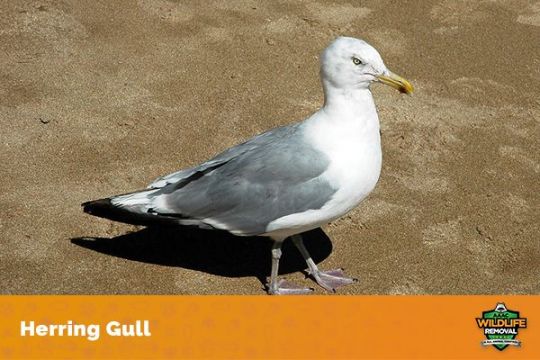
Herring gull
Herring gulls are medium to large seabirds. They are white with grey wings and a yellow bill with a red spot. Adults have light grey legs and feet, and their irises are dark brown. Immature gulls have pale eyes, and their legs and feet are often pinkish.
Adult herring gulls have white bodies, gray wings and backs, black wingtips, and pink legs. Unlike European herring gulls, these birds have darker tails that are gray-brown, darker, and more uniformly colored. It is frequently seen in rubbish dumps, lakes, rivers, and coastal areas. The bird typically builds a nest close to water, laying three or four eggs in a hole dug in the ground. Invertebrates, fish, and various other foods are part of its varied diet.
In shades of olive, green, or brownish-green, gull eggs blend in beautifully. While some species have browner and greener eggs, they all resemble one another. They prefer to blend in well with the mossy or rocky habitats in which they live.

Tawny owl
The tawny owl is a predatory bird of the night. Due to adaptations to its vision, hearing, and ability to fly quietly, it is able to locate and capture prey in the dark. It hunts primarily rodents, birds, and bats by ear and sound location.
The tawny owl has a round head, no ear tufts, and yellow eyes. Its upper parts are streaked brown and its underparts are pale with dark streaks. The facial disc surrounding the eyes is generally pale with a dark border.
The glossy white eggs are 48 x 39 mm in size and weigh 39.0g, which is 7% of the shell.
House martin
The common house martin, also known as the northern house martin or, more commonly, just house martin, is a migratory passerine bird of the swallow family that spends the winters in sub-Saharan Africa and tropical Asia and breeds in Europe, north Africa, and across the Palearctic. It migrates to regions with an abundance of flying insects and feeds on insects that are caught in flight. It can be found in both open areas and close to populated areas. It has a blue head and top parts, a white rump, and all-white underparts.
They hatch four to five soft, pure white eggs, average 1.9 cm by 1.33 cm in size, and weigh 1.7 g.
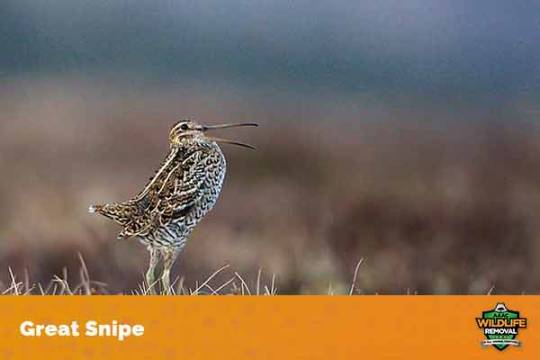
Great snipe
The great snipe is a wading bird in the sandpiper family. It has a very long bill and is mottled brown above with creamy-buff stripes on its flanks. The underparts are white, sometimes with a brown tinge, and there is a faint stripe over the eye. In flight, it shows a broad white wingbar.
The great snipe has a dark stripe eye and a brown body. The large wings have a light wing bar in flight. North-eastern Europe, especially north-western Russia, has marshes and wet meadows with short vegetation where the great snipe breeds. Great snipes migrate and spend their winters in Africa.
They produce olive-colored eggs with dark brown, black, or purple splotches. With a 1.4-1.7 in length and a 1.0-1.2 in width.
Chicken
The chicken is a type of domesticated jungle fowl that shares characteristics with wild species like the grey and Ceylon junglefowl, which are native to Southeast Asia. A juvenile male bird or a cockerel, and an adult male bird is known as a cock or rooster. A hen is an adult female bird.
A small hen's egg or many eggs are white and brown, but a green or bright blue egg is also possible. The shells of a chicken egg have a smooth and porous surface.
Chough
The choughs, which live in the highlands of southern Eurasia and North Africa, have black plumage with colorful legs, feet, and beaks. They fly spectacularly and have long, broad wings. Both species form lifelong pairs and show loyalty to the caves or cliff wall fissures where they nest. They consume short-grazed grassland in flocks and typically eat mostly invertebrate prey, supplemented by vegetables or food from human settlement, particularly in the winter.
They lay a few large dark speckled, cream-colored eggs. Choughs produce three to five eggs, weighing 15.7g and measuring 39-28 mm.
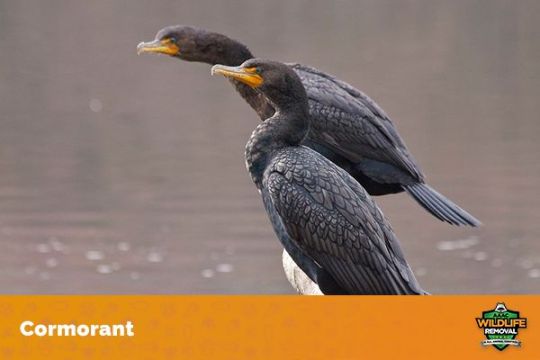
Cormorant
Cormorants are medium-to-large birds with a body weight of 0.35 to 5 kg and a wing span of 60 to 100 cm include cormorants and shags. Dark feathers are present in the majority of species. Each of their four toes has webbing between them. All species are fish eaters who dive from the surface to get their meal.
They are skilled divers who use their feet to move forward underwater with the assistance of their wings. Some dive as deep as 45 meters. Due to their necessity for efficient underwater movement and relatively short wings, they have one of the most calorically expensive flights of any flying bird.
They lay unmarked pale blue eggs measuring 5.6-7 cm in length and 3.5-4 cm in width.

Osprey
The fish-eating, nocturnal osprey, also known as the sea hawk, river hawk, and fish hawk, has a wide geographic range. It is a sizable raptor that can grow to be more than 60 cm long and 180 cm across the wings. The head and underparts are primarily greyish, while the upper parts are brown.
The eggs laid are mottled or speckled with red or dark brown, ranging in color from dirty white to light brown. The eggs are about the size of chicken eggs and weigh 60-80gm each. The first egg is the largest, and the next ones get smaller one or two days later.
Emu
The emu is the second-tallest living big bird after the ostrich. Emus are brown, flightless birds with soft feathers that may grow up to 1.9 meters in height. They also have long necks and legs. Emus go for weeks without eating, although they can travel enormous distances and sprint at 48 km/h when necessary.
Emu lays eggs in an intense green shade with blueish tones. The natural pigment progressively fades with exposure to light, changing the color of the surface to a greyish brown. Emu eggs range in size from 400 to 700 grams and are typically about 13 x 9 cm.
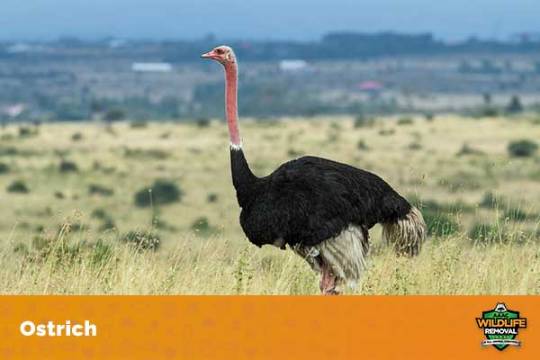
Ostrich
The ratites, including ostritches, emus, rheas, and kiwis, are a diversified group of giant flightless birds.. The common ostrich and the Somali ostrich are the only two species of ostrich that exist today. They are indigenous to Africa. They can run at 70 km/h, making them the quickest birds on land. They are raised worldwide, especially for their feathers which are used as dusters and ornaments. Additionally, their skin is used to make leather goods. The fact that ostriches are the heaviest living birds is noteworthy.
An ostrich egg is a massive, with an egg size measuring 15 cm long, 13 cm wide, and weighing 1.4 kg, on average. The shell is 1-2 mm thick and has a porosity of about 70%. They are spherical and smooth with a glossy surface.
Birds Nesting On Your Gutter or Vent? We'll Remove Them For You!
If you need help with birds and their nesting or other animals on your property, AAAC Wildlife Removal is here to help. We are experts in the field of animal and bird removal, and we can get rid of any problem you may have. We also offer a variety of other services to keep your home or business free of pests. Contact us today to learn more!
Conclusion
Well, that was quite a list! As you can see, many different types of birds and their eggs are as diverse as they are. Some are small and some are large. Some are colorful and some are not. But they all have one thing in common- they are all amazing!
So, the next time you see a bird, take a moment to appreciate all that it is and all that it does. And if you're ever in the market for bird removal services, be sure to give AAAC Wildlife Removal a call! We would be more than happy to help you out!
Locally Published on: https://florence.aaacwildliferemoval.com/blog/birds/birds-and-their-eggs/
0 notes
Text
Birds And Their Eggs
There are so many different types of birds: Waterfowl (Anseriformes), Birds of Prey (Accipitriformes), Hummingbirds (Apodiformes), Nightjars (Caprimulgiformes)... The list goes on and on! But have you ever wondered what their eggs look like?
Let's explore the types of birds and their eggs.

How to identify birds' eggs
Identifying bird’s eggs can be tricky, even for experienced birders. But with a bit of practice, you'll be able to tell the difference between the eggs of many birds.
The first step in identifying a bird's egg is determining its size. Bird eggs come in all different sizes, from tiny hummingbird eggs to huge ostrich eggs. Take a look at the color, Bird eggs can be white, blue, green, brown, or any combination of these colors. Finally, there are usually markings. Some eggs have spots, while others have different markings.
That's probably the basics of identifying eggs. And now let's know more about the birds and their eggs.

Great tit
The great tit is a recognizable bird with a black head and neck, prominent white cheeks, olive upperparts, and yellow underparts. In the summer, it mainly eats insects. In the winter, it will consume a wider variety of foods, including little bats that are hibernating.
Great tit eggs measure 17.5 x 13.5mm and have a slight sheen. They have varying degrees of reddish or purplish speckling over their white background.
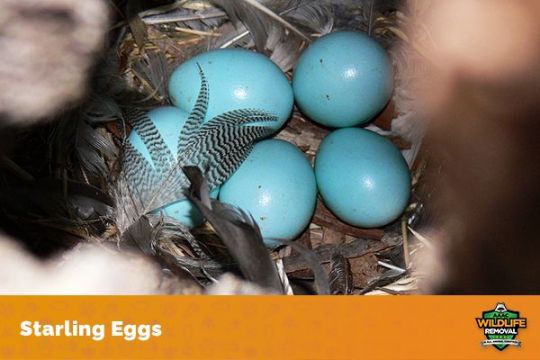
Starling
In addition to northern Australia and the islands of the tropical Pacific, starlings are endemic to Europe, Asia, and Africa. Many species from Europe and Asia have been imported to these regions, as well as to North America, Hawaii, and New Zealand. They are regarded as invasive species because they frequently compete with native birds for habitat. The common starling is the species most people in Europe and North America are familiar with.
Starlings are exceedingly sociable, with powerful feet, and a strong, direct flight. They eat insects and fruit and enjoy an open, rural environment for their habitat. Many creatures that dwell close to human settlements are essentially omnivores.
Sized at 30 x 21 mm, starling eggshells are smooth and relatively glossy. They are typically pale blue-green bird eggs.
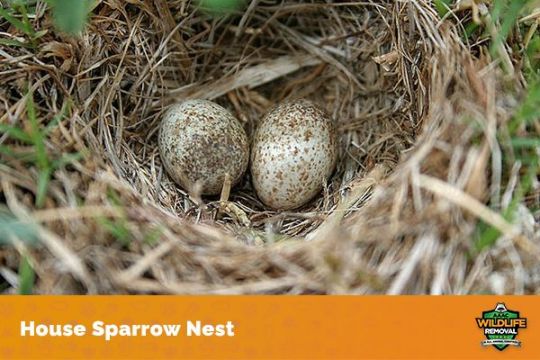
House sparrow
Male house sparrows have more vivid black, white, and brown markings whereas females and young birds are colored a light brown and grey. Native to much of Asia, the Mediterranean region, and most of Europe. It is the most extensively dispersed wild bird due to its deliberate or unintentional imports to numerous areas, including sections of Australasia, Africa, and the Americas.
The house sparrow, which can be found in both urban and rural areas, is closely related to human habitation. Although it can be found in a broad variety of habitats and climates, it normally stays away from vast woodlands, meadows, and deserts that are not well developed by humans. Although it is an opportunistic eater and frequently consumes insects and a variety of other things, it primarily consumes the seeds of weeds and grains.
House sparrow hatching eggs are slightly glossy, 22.5 x 15.5 mm eggs. White with variable amounts of dark brown and blue-grey speckling.
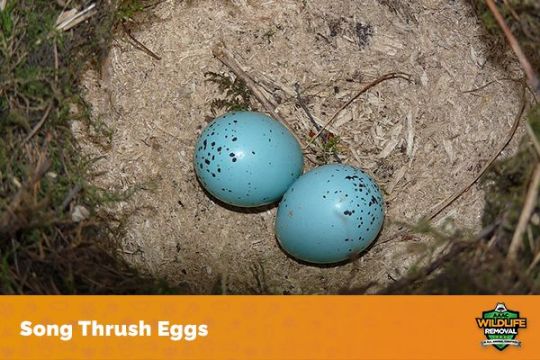
Song thrush
The song thrush is a migratory species with brown top parts and cream or buff underparts with black spots. The song thrush nests in forests, gardens, and parks. Even though it is not in danger internationally, there have been significant population losses in some regions of Europe, probably as a result of modifications to farming methods.
A whole egg from song thrushes is 31 x 22 mm in size, smooth and lustrous. They are light blue eggs with a few noticeable, sizable dark specks, mainly at the wide end.

Hummingbird
The tropics are where the vast majority of Hummingbird species are found. They are little birds, with the majority of species measuring between 7.5 and 13 cm. The bee hummingbird, which measures 5 cm and weighs less than 2.0 g, is the smallest species of hummingbird still living (0.07 oz). The 23 cm enormous hummingbird, which weighs 18-24 grams, is the largest species of hummingbird. Although all species eat flying insects or spiders, they are adapted for feeding on flower nectar.
Hummingbird eggs are white and elliptical and are small eggs about the size of a small jelly bean. Most are less than a gram or the weight of a paperclip!
Blackbird
Depending on latitude, the blackbird can be resident, partially, or fully migratory. Located throughout most of Europe, it has a rich, musical singing voice. It is primarily black or dark, dark brown with yellow eyes beak. The adult female and juvenile have mostly dark brown feathers. This species builds a tidy, cup-shaped nest tied together with mud to reproduce in gardens and woods.
Blackbird eggs are pretty striking. The size of three centimeters, green, blue in color, and covered in brown dots.
Robin
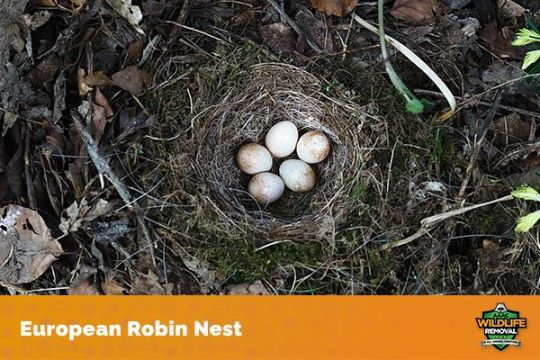
The European Robin
A tiny insectivorous bird also referred to as the robin or the robin redbreast in the British Isles. The male and female are similar in color, measuring around 12.5-14.0 cm in length, with an orange breast and face bordered with grey and brown middle parts and a creamy belly. It is widespread throughout Europe, extends east to Western Siberia, and south to North Africa. They tend not to migrate, but a subset of robins do move around based on the season and latitude of their habitat.
The eggs are cream, or white with reddish-brown spots, which are frequently more prominent at the larger hemisphere of the egg.

The American robin
A songbird that migrates. Although the two species are not closely related and the European robin is a member of the Old World flycatcher family, it was named after the European robin because of its reddish-orange breast. The American robin can be found all over North America; it winters along the Pacific Coast, in southern Canada, and in central Mexico. It is the national bird of Wisconsin, Michigan, and Connecticut.
The pigment biliverdin is responsible for the blue color of robin eggs when the eggs hatch. There is evidence that the more blue the eggs appear and the healthier the female are associated with elevated biliverdin levels.
Dunnock
The dunnock is a little perching or passerine bird that lives in temperate Europe and Asian Russia. It is also known as the hedge sparrow or hedge accentor. The dunnock is brown above and has a grey breast with two dark streaks. It has a pointed bill and long legs for its size, which is around 15 cm.
A dunnock's egg is pale blue with dark brown spots, and they measure 20 x 15mm and have a matte finish.

Pheasant
Pheasants are a family of birds that includes partridges, quails, francolins, and junglefowls. The pheasant is a gamebird that is native to Asia and has been introduced to Europe, Africa, and North America. It is the national bird of Hungary. The male pheasant is very colorful with a long tail and bare red facial skin. The female is much less colorful and has a shorter tail.
Eggs from pheasants are beautiful. They have a gorgeous pale, olive-green (or occasionally brown) shell and are around half the size of a hen's egg and twice the size of a quail's egg. They have a bright yellow yolk inside.
Canada goose
The Canada goose, often known as the Canadian goose, is a sizable wild bird with a grey body, a black head and neck, white cheeks, and white beneath its chin. In addition to being frequently seen on or near freshwater, the Canada goose is also widespread in saline marshes, estuaries, and lagoons. They are herbivorous and usually migratory.
Each egg measures 2.2 inches in width and 3.3 inches in length (8.3 cm) (5.6 centimeters). The color of the eggs is a creamy white. Goslings are born with their eyes open and coated in a light yellow tint.

Mallard
The mallard, known as the wild duck, is a dabbling duck that breeds throughout the temperate and subtropical Americas, Eurasia, and North Africa. Males typically have blue speculum feathers, although both sexes have a region of white-bordered black or iridescent blue feathers on their wings. The females (hens) have mostly brown-speckled feathers, while the males have purple spots on their wings.
Eggs laid by mallard ducks can be anything from white to light blue. They can also occasionally be bluish-green. The eggs of a wild mallard are a creamy white color without any markings. Additionally, they appear as a soft blue-green.
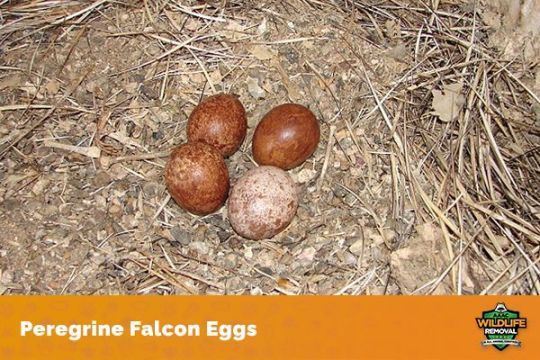
Peregrine falcon
The peregrine falcon also called duck hawk in North America, is a black head, barred white underparts, and a massive falcon with a crow-sized body. It is noted for its speed, reaching up to 320 km/h during its distinctive hunting stoop.
The Arctic tundra to the tropics is the peregrine's nesting range. Except for the most severe polar regions, extremely high mountains, and tropical rainforests. New Zealand is the only significant ice-free landmass where it is absent. It makes it one of the most ubiquitous bird species and the most common raptor worldwide.
Typically, a peregrine falcon's female lays 3 to 4 eggs with dark, reddish-brown pigment dotted throughout the eggs, slightly smaller than chicken eggs.

Herring gull
Herring gulls are medium to large seabirds. They are white with grey wings and a yellow bill with a red spot. Adults have light grey legs and feet, and their irises are dark brown. Immature gulls have pale eyes, and their legs and feet are often pinkish.
Adult herring gulls have white bodies, gray wings and backs, black wingtips, and pink legs. Unlike European herring gulls, these birds have darker tails that are gray-brown, darker, and more uniformly colored. It is frequently seen in rubbish dumps, lakes, rivers, and coastal areas. The bird typically builds a nest close to water, laying three or four eggs in a hole dug in the ground. Invertebrates, fish, and various other foods are part of its varied diet.
In shades of olive, green, or brownish-green, gull eggs blend in beautifully. While some species have browner and greener eggs, they all resemble one another. They prefer to blend in well with the mossy or rocky habitats in which they live.
Tawny owl
The tawny owl is a predatory bird of the night. Due to adaptations to its vision, hearing, and ability to fly quietly, it is able to locate and capture prey in the dark. It hunts primarily rodents, birds, and bats by ear and sound location.
The tawny owl has a round head, no ear tufts, and yellow eyes. Its upper parts are streaked brown and its underparts are pale with dark streaks. The facial disc surrounding the eyes is generally pale with a dark border.
The glossy white eggs are 48 x 39 mm in size and weigh 39.0g, which is 7% of the shell.

House martin
The common house martin, also known as the northern house martin or, more commonly, just house martin, is a migratory passerine bird of the swallow family that spends the winters in sub-Saharan Africa and tropical Asia and breeds in Europe, north Africa, and across the Palearctic. It migrates to regions with an abundance of flying insects and feeds on insects that are caught in flight. It can be found in both open areas and close to populated areas. It has a blue head and top parts, a white rump, and all-white underparts.
They hatch four to five soft, pure white eggs, average 1.9 cm by 1.33 cm in size, and weigh 1.7 g.

Great snipe
The great snipe is a wading bird in the sandpiper family. It has a very long bill and is mottled brown above with creamy-buff stripes on its flanks. The underparts are white, sometimes with a brown tinge, and there is a faint stripe over the eye. In flight, it shows a broad white wingbar.
The great snipe has a dark stripe eye and a brown body. The large wings have a light wing bar in flight. North-eastern Europe, especially north-western Russia, has marshes and wet meadows with short vegetation where the great snipe breeds. Great snipes migrate and spend their winters in Africa.
They produce olive-colored eggs with dark brown, black, or purple splotches. With a 1.4-1.7 in length and a 1.0-1.2 in width.
Chicken
The chicken is a type of domesticated jungle fowl that shares characteristics with wild species like the grey and Ceylon junglefowl, which are native to Southeast Asia. A juvenile male bird or a cockerel, and an adult male bird is known as a cock or rooster. A hen is an adult female bird.
A small hen's egg or many eggs are white and brown, but a green or bright blue egg is also possible. The shells of a chicken egg have a smooth and porous surface.
Chough
The choughs, which live in the highlands of southern Eurasia and North Africa, have black plumage with colorful legs, feet, and beaks. They fly spectacularly and have long, broad wings. Both species form lifelong pairs and show loyalty to the caves or cliff wall fissures where they nest. They consume short-grazed grassland in flocks and typically eat mostly invertebrate prey, supplemented by vegetables or food from human settlement, particularly in the winter.
They lay a few large dark speckled, cream-colored eggs. Choughs produce three to five eggs, weighing 15.7g and measuring 39-28 mm.
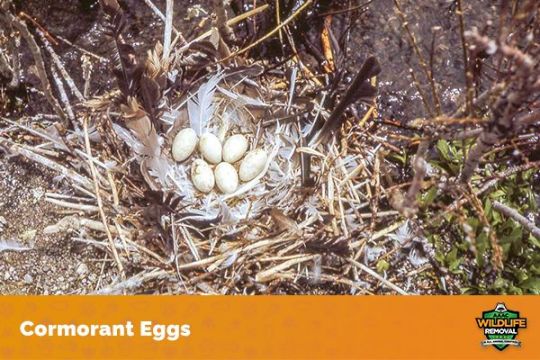
Cormorant
Cormorants are medium-to-large birds with a body weight of 0.35 to 5 kg and a wing span of 60 to 100 cm include cormorants and shags. Dark feathers are present in the majority of species. Each of their four toes has webbing between them. All species are fish eaters who dive from the surface to get their meal.
They are skilled divers who use their feet to move forward underwater with the assistance of their wings. Some dive as deep as 45 meters. Due to their necessity for efficient underwater movement and relatively short wings, they have one of the most calorically expensive flights of any flying bird.
They lay unmarked pale blue eggs measuring 5.6-7 cm in length and 3.5-4 cm in width.

Osprey
The fish-eating, nocturnal osprey, also known as the sea hawk, river hawk, and fish hawk, has a wide geographic range. It is a sizable raptor that can grow to be more than 60 cm long and 180 cm across the wings. The head and underparts are primarily greyish, while the upper parts are brown.
The eggs laid are mottled or speckled with red or dark brown, ranging in color from dirty white to light brown. The eggs are about the size of chicken eggs and weigh 60-80gm each. The first egg is the largest, and the next ones get smaller one or two days later.
Emu
The emu is the second-tallest living big bird after the ostrich. Emus are brown, flightless birds with soft feathers that may grow up to 1.9 meters in height. They also have long necks and legs. Emus go for weeks without eating, although they can travel enormous distances and sprint at 48 km/h when necessary.
Emu lays eggs in an intense green shade with blueish tones. The natural pigment progressively fades with exposure to light, changing the color of the surface to a greyish brown. Emu eggs range in size from 400 to 700 grams and are typically about 13 x 9 cm.
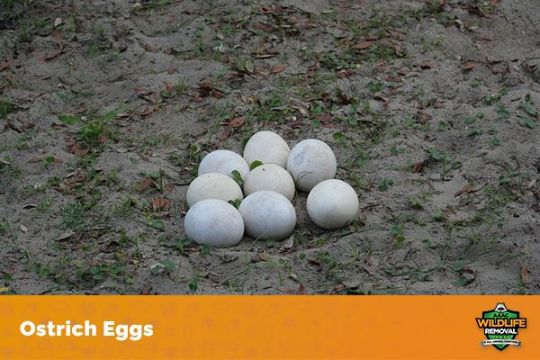
Ostrich
The ratites, including ostritches, emus, rheas, and kiwis, are a diversified group of giant flightless birds.. The common ostrich and the Somali ostrich are the only two species of ostrich that exist today. They are indigenous to Africa. They can run at 70 km/h, making them the quickest birds on land. They are raised worldwide, especially for their feathers which are used as dusters and ornaments. Additionally, their skin is used to make leather goods. The fact that ostriches are the heaviest living birds is noteworthy.
An ostrich egg is a massive, with an egg size measuring 15 cm long, 13 cm wide, and weighing 1.4 kg, on average. The shell is 1-2 mm thick and has a porosity of about 70%. They are spherical and smooth with a glossy surface.
Birds Nesting On Your Gutter or Vent? We'll Remove Them For You!
If you need help with birds and their nesting or other animals on your property, AAAC Wildlife Removal is here to help. We are experts in the field of animal and bird removal, and we can get rid of any problem you may have. We also offer a variety of other services to keep your home or business free of pests. Contact us today to learn more!
Conclusion
Well, that was quite a list! As you can see, many different types of birds and their eggs are as diverse as they are. Some are small and some are large. Some are colorful and some are not. But they all have one thing in common- they are all amazing!
So, the next time you see a bird, take a moment to appreciate all that it is and all that it does. And if you're ever in the market for bird removal services, be sure to give AAAC Wildlife Removal a call! We would be more than happy to help you out!
Locally Published on: https://mobile.aaacwildliferemoval.com/blog/birds/birds-and-their-eggs/
0 notes
Text
Birds And Their Eggs
There are so many different types of birds: Waterfowl (Anseriformes), Birds of Prey (Accipitriformes), Hummingbirds (Apodiformes), Nightjars (Caprimulgiformes)… The list goes on and on! But have you ever wondered what their eggs look like?
Let’s explore the types of birds and their eggs.
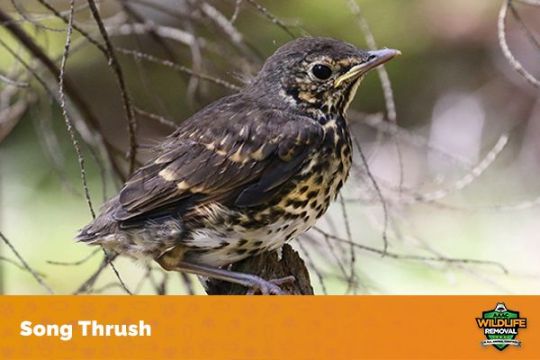
How to identify birds’ eggs
Identifying bird’s eggs can be tricky, even for experienced birders. But with a bit of practice, you’ll be able to tell the difference between the eggs of many birds.
The first step in identifying a bird’s egg is determining its size. Bird eggs come in all different sizes, from tiny hummingbird eggs to huge ostrich eggs. Take a look at the color, Bird eggs can be white, blue, green, brown, or any combination of these colors. Finally, there are usually markings. Some eggs have spots, while others have different markings.
That’s probably the basics of identifying eggs. And now let’s know more about the birds and their eggs.
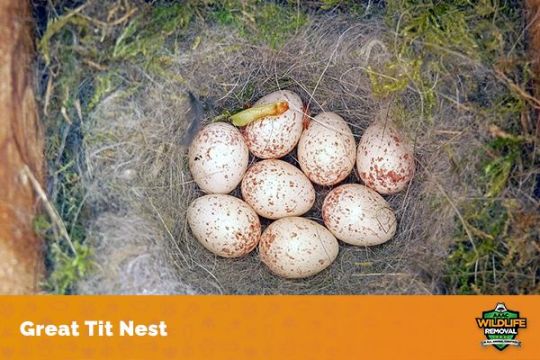
Great tit
The great tit is a recognizable bird with a black head and neck, prominent white cheeks, olive upperparts, and yellow underparts. In the summer, it mainly eats insects. In the winter, it will consume a wider variety of foods, including little bats that are hibernating.
Great tit eggs measure 17.5 x 13.5mm and have a slight sheen. They have varying degrees of reddish or purplish speckling over their white background.
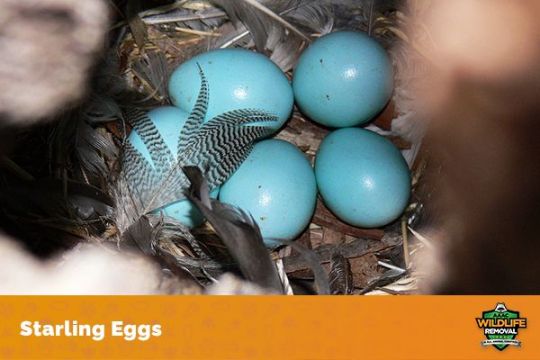
Starling
In addition to northern Australia and the islands of the tropical Pacific, starlings are endemic to Europe, Asia, and Africa. Many species from Europe and Asia have been imported to these regions, as well as to North America, Hawaii, and New Zealand. They are regarded as invasive species because they frequently compete with native birds for habitat. The common starling is the species most people in Europe and North America are familiar with.
Starlings are exceedingly sociable, with powerful feet, and a strong, direct flight. They eat insects and fruit and enjoy an open, rural environment for their habitat. Many creatures that dwell close to human settlements are essentially omnivores.
Sized at 30 x 21 mm, starling eggshells are smooth and relatively glossy. They are typically pale blue-green bird eggs.

House sparrow
Male house sparrows have more vivid black, white, and brown markings whereas females and young birds are colored a light brown and grey. Native to much of Asia, the Mediterranean region, and most of Europe. It is the most extensively dispersed wild bird due to its deliberate or unintentional imports to numerous areas, including sections of Australasia, Africa, and the Americas.
The house sparrow, which can be found in both urban and rural areas, is closely related to human habitation. Although it can be found in a broad variety of habitats and climates, it normally stays away from vast woodlands, meadows, and deserts that are not well developed by humans. Although it is an opportunistic eater and frequently consumes insects and a variety of other things, it primarily consumes the seeds of weeds and grains.
House sparrow hatching eggs are slightly glossy, 22.5 x 15.5 mm eggs. White with variable amounts of dark brown and blue-grey speckling.
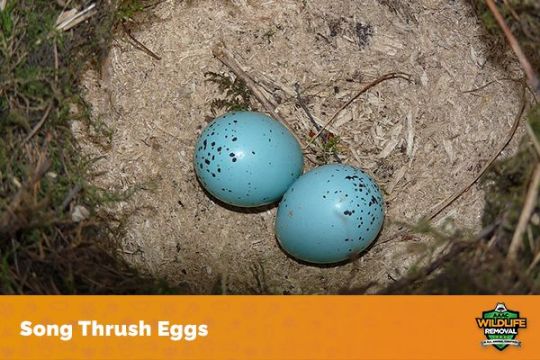
Song thrush
The song thrush is a migratory species with brown top parts and cream or buff underparts with black spots. The song thrush nests in forests, gardens, and parks. Even though it is not in danger internationally, there have been significant population losses in some regions of Europe, probably as a result of modifications to farming methods.
A whole egg from song thrushes is 31 x 22 mm in size, smooth and lustrous. They are light blue eggs with a few noticeable, sizable dark specks, mainly at the wide end.
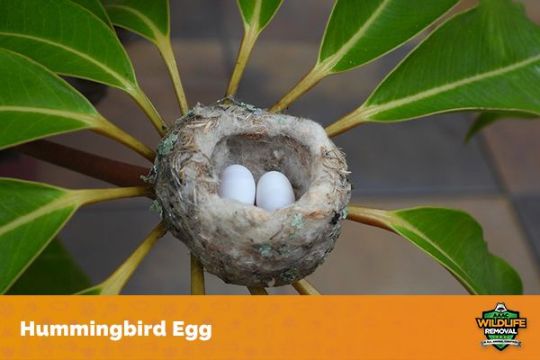
Hummingbird
The tropics are where the vast majority of Hummingbird species are found. They are little birds, with the majority of species measuring between 7.5 and 13 cm. The bee hummingbird, which measures 5 cm and weighs less than 2.0 g, is the smallest species of hummingbird still living (0.07 oz). The 23 cm enormous hummingbird, which weighs 18-24 grams, is the largest species of hummingbird. Although all species eat flying insects or spiders, they are adapted for feeding on flower nectar.
Hummingbird eggs are white and elliptical and are small eggs about the size of a small jelly bean. Most are less than a gram or the weight of a paperclip!
Blackbird
Depending on latitude, the blackbird can be resident, partially, or fully migratory. Located throughout most of Europe, it has a rich, musical singing voice. It is primarily black or dark, dark brown with yellow eyes beak. The adult female and juvenile have mostly dark brown feathers. This species builds a tidy, cup-shaped nest tied together with mud to reproduce in gardens and woods.
Blackbird eggs are pretty striking. The size of three centimeters, green, blue in color, and covered in brown dots.
Robin

The European Robin
A tiny insectivorous bird also referred to as the robin or the robin redbreast in the British Isles. The male and female are similar in color, measuring around 12.5-14.0 cm in length, with an orange breast and face bordered with grey and brown middle parts and a creamy belly. It is widespread throughout Europe, extends east to Western Siberia, and south to North Africa. They tend not to migrate, but a subset of robins do move around based on the season and latitude of their habitat.
The eggs are cream, or white with reddish-brown spots, which are frequently more prominent at the larger hemisphere of the egg.

The American robin
A songbird that migrates. Although the two species are not closely related and the European robin is a member of the Old World flycatcher family, it was named after the European robin because of its reddish-orange breast. The American robin can be found all over North America; it winters along the Pacific Coast, in southern Canada, and in central Mexico. It is the national bird of Wisconsin, Michigan, and Connecticut.
The pigment biliverdin is responsible for the blue color of robin eggs when the eggs hatch. There is evidence that the more blue the eggs appear and the healthier the female are associated with elevated biliverdin levels.
Dunnock
The dunnock is a little perching or passerine bird that lives in temperate Europe and Asian Russia. It is also known as the hedge sparrow or hedge accentor. The dunnock is brown above and has a grey breast with two dark streaks. It has a pointed bill and long legs for its size, which is around 15 cm.
A dunnock’s egg is pale blue with dark brown spots, and they measure 20 x 15mm and have a matte finish.
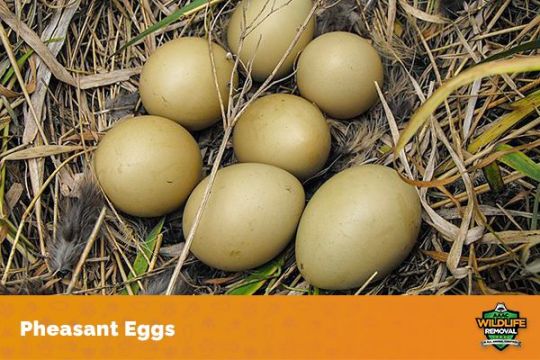
Pheasant
Pheasants are a family of birds that includes partridges, quails, francolins, and junglefowls. The pheasant is a gamebird that is native to Asia and has been introduced to Europe, Africa, and North America. It is the national bird of Hungary. The male pheasant is very colorful with a long tail and bare red facial skin. The female is much less colorful and has a shorter tail.
Eggs from pheasants are beautiful. They have a gorgeous pale, olive-green (or occasionally brown) shell and are around half the size of a hen’s egg and twice the size of a quail’s egg. They have a bright yellow yolk inside.
Canada goose
The Canada goose, often known as the Canadian goose, is a sizable wild bird with a grey body, a black head and neck, white cheeks, and white beneath its chin. In addition to being frequently seen on or near freshwater, the Canada goose is also widespread in saline marshes, estuaries, and lagoons. They are herbivorous and usually migratory.
Each egg measures 2.2 inches in width and 3.3 inches in length (8.3 cm) (5.6 centimeters). The color of the eggs is a creamy white. Goslings are born with their eyes open and coated in a light yellow tint.
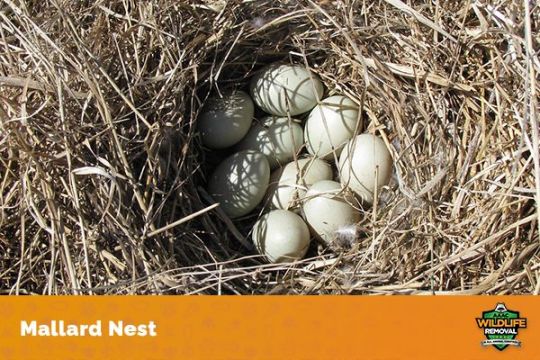
Mallard
The mallard, known as the wild duck, is a dabbling duck that breeds throughout the temperate and subtropical Americas, Eurasia, and North Africa. Males typically have blue speculum feathers, although both sexes have a region of white-bordered black or iridescent blue feathers on their wings. The females (hens) have mostly brown-speckled feathers, while the males have purple spots on their wings.
Eggs laid by mallard ducks can be anything from white to light blue. They can also occasionally be bluish-green. The eggs of a wild mallard are a creamy white color without any markings. Additionally, they appear as a soft blue-green.

Peregrine falcon
The peregrine falcon also called duck hawk in North America, is a black head, barred white underparts, and a massive falcon with a crow-sized body. It is noted for its speed, reaching up to 320 km/h during its distinctive hunting stoop.
The Arctic tundra to the tropics is the peregrine’s nesting range. Except for the most severe polar regions, extremely high mountains, and tropical rainforests. New Zealand is the only significant ice-free landmass where it is absent. It makes it one of the most ubiquitous bird species and the most common raptor worldwide.
Typically, a peregrine falcon’s female lays 3 to 4 eggs with dark, reddish-brown pigment dotted throughout the eggs, slightly smaller than chicken eggs.

Herring gull
Herring gulls are medium to large seabirds. They are white with grey wings and a yellow bill with a red spot. Adults have light grey legs and feet, and their irises are dark brown. Immature gulls have pale eyes, and their legs and feet are often pinkish.
Adult herring gulls have white bodies, gray wings and backs, black wingtips, and pink legs. Unlike European herring gulls, these birds have darker tails that are gray-brown, darker, and more uniformly colored. It is frequently seen in rubbish dumps, lakes, rivers, and coastal areas. The bird typically builds a nest close to water, laying three or four eggs in a hole dug in the ground. Invertebrates, fish, and various other foods are part of its varied diet.
In shades of olive, green, or brownish-green, gull eggs blend in beautifully. While some species have browner and greener eggs, they all resemble one another. They prefer to blend in well with the mossy or rocky habitats in which they live.
Tawny owl
The tawny owl is a predatory bird of the night. Due to adaptations to its vision, hearing, and ability to fly quietly, it is able to locate and capture prey in the dark. It hunts primarily rodents, birds, and bats by ear and sound location.
The tawny owl has a round head, no ear tufts, and yellow eyes. Its upper parts are streaked brown and its underparts are pale with dark streaks. The facial disc surrounding the eyes is generally pale with a dark border.
The glossy white eggs are 48 x 39 mm in size and weigh 39.0g, which is 7% of the shell.
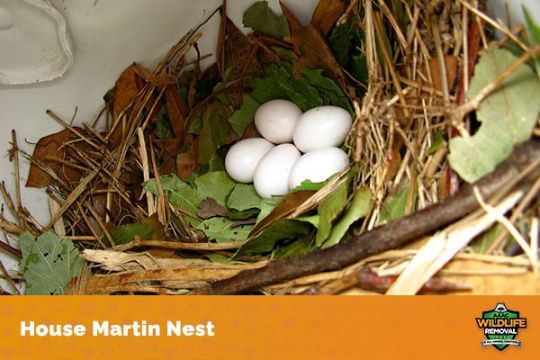
House martin
The common house martin, also known as the northern house martin or, more commonly, just house martin, is a migratory passerine bird of the swallow family that spends the winters in sub-Saharan Africa and tropical Asia and breeds in Europe, north Africa, and across the Palearctic. It migrates to regions with an abundance of flying insects and feeds on insects that are caught in flight. It can be found in both open areas and close to populated areas. It has a blue head and top parts, a white rump, and all-white underparts.
They hatch four to five soft, pure white eggs, average 1.9 cm by 1.33 cm in size, and weigh 1.7 g.
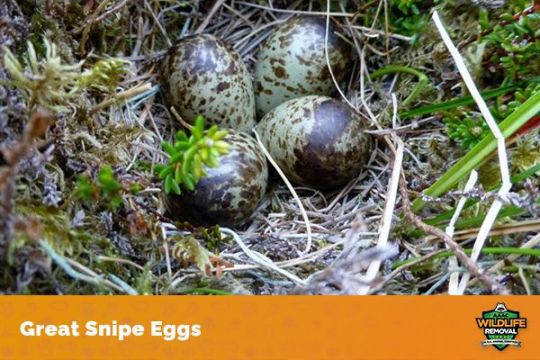
Great snipe
The great snipe is a wading bird in the sandpiper family. It has a very long bill and is mottled brown above with creamy-buff stripes on its flanks. The underparts are white, sometimes with a brown tinge, and there is a faint stripe over the eye. In flight, it shows a broad white wingbar.
The great snipe has a dark stripe eye and a brown body. The large wings have a light wing bar in flight. North-eastern Europe, especially north-western Russia, has marshes and wet meadows with short vegetation where the great snipe breeds. Great snipes migrate and spend their winters in Africa.
They produce olive-colored eggs with dark brown, black, or purple splotches. With a 1.4-1.7 in length and a 1.0-1.2 in width.
Chicken
The chicken is a type of domesticated jungle fowl that shares characteristics with wild species like the grey and Ceylon junglefowl, which are native to Southeast Asia. A juvenile male bird or a cockerel, and an adult male bird is known as a cock or rooster. A hen is an adult female bird.
A small hen’s egg or many eggs are white and brown, but a green or bright blue egg is also possible. The shells of a chicken egg have a smooth and porous surface.
Chough
The choughs, which live in the highlands of southern Eurasia and North Africa, have black plumage with colorful legs, feet, and beaks. They fly spectacularly and have long, broad wings. Both species form lifelong pairs and show loyalty to the caves or cliff wall fissures where they nest. They consume short-grazed grassland in flocks and typically eat mostly invertebrate prey, supplemented by vegetables or food from human settlement, particularly in the winter.
They lay a few large dark speckled, cream-colored eggs. Choughs produce three to five eggs, weighing 15.7g and measuring 39-28 mm.
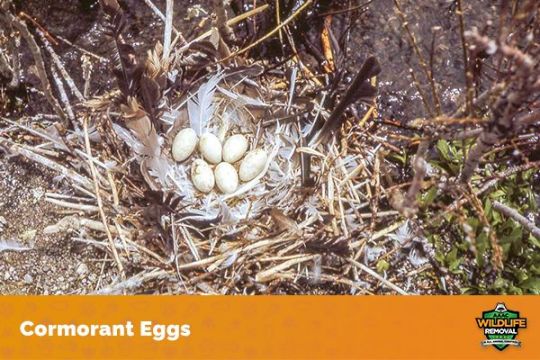
Cormorant
Cormorants are medium-to-large birds with a body weight of 0.35 to 5 kg and a wing span of 60 to 100 cm include cormorants and shags. Dark feathers are present in the majority of species. Each of their four toes has webbing between them. All species are fish eaters who dive from the surface to get their meal.
They are skilled divers who use their feet to move forward underwater with the assistance of their wings. Some dive as deep as 45 meters. Due to their necessity for efficient underwater movement and relatively short wings, they have one of the most calorically expensive flights of any flying bird.
They lay unmarked pale blue eggs measuring 5.6-7 cm in length and 3.5-4 cm in width.

Osprey
The fish-eating, nocturnal osprey, also known as the sea hawk, river hawk, and fish hawk, has a wide geographic range. It is a sizable raptor that can grow to be more than 60 cm long and 180 cm across the wings. The head and underparts are primarily greyish, while the upper parts are brown.
The eggs laid are mottled or speckled with red or dark brown, ranging in color from dirty white to light brown. The eggs are about the size of chicken eggs and weigh 60-80gm each. The first egg is the largest, and the next ones get smaller one or two days later.
Emu
The emu is the second-tallest living big bird after the ostrich. Emus are brown, flightless birds with soft feathers that may grow up to 1.9 meters in height. They also have long necks and legs. Emus go for weeks without eating, although they can travel enormous distances and sprint at 48 km/h when necessary.
Emu lays eggs in an intense green shade with blueish tones. The natural pigment progressively fades with exposure to light, changing the color of the surface to a greyish brown. Emu eggs range in size from 400 to 700 grams and are typically about 13 x 9 cm.

Ostrich
The ratites, including ostritches, emus, rheas, and kiwis, are a diversified group of giant flightless birds.. The common ostrich and the Somali ostrich are the only two species of ostrich that exist today. They are indigenous to Africa. They can run at 70 km/h, making them the quickest birds on land. They are raised worldwide, especially for their feathers which are used as dusters and ornaments. Additionally, their skin is used to make leather goods. The fact that ostriches are the heaviest living birds is noteworthy.
An ostrich egg is a massive, with an egg size measuring 15 cm long, 13 cm wide, and weighing 1.4 kg, on average. The shell is 1-2 mm thick and has a porosity of about 70%. They are spherical and smooth with a glossy surface.
Birds Nesting On Your Gutter or Vent? We’ll Remove Them For You!
If you need help with birds and their nesting or other animals on your property, AAAC Wildlife Removal is here to help. We are experts in the field of animal and bird removal, and we can get rid of any problem you may have. We also offer a variety of other services to keep your home or business free of pests. Contact us today to learn more!
Conclusion
Well, that was quite a list! As you can see, many different types of birds and their eggs are as diverse as they are. Some are small and some are large. Some are colorful and some are not. But they all have one thing in common- they are all amazing!
So, the next time you see a bird, take a moment to appreciate all that it is and all that it does. And if you’re ever in the market for bird removal services, be sure to give AAAC Wildlife Removal a call! We would be more than happy to help you out!
Locally Published on: https://fort-worth.aaacwildliferemoval.com/blog/birds/birds-and-their-eggs/
from AAAC Wildlife Removal of Fort Worth https://fortworthwildliferemoval.tumblr.com/post/692294041328648192
0 notes
Text
Birds And Their Eggs
There are so many different types of birds: Waterfowl (Anseriformes), Birds of Prey (Accipitriformes), Hummingbirds (Apodiformes), Nightjars (Caprimulgiformes)... The list goes on and on! But have you ever wondered what their eggs look like?
Let's explore the types of birds and their eggs.

How to identify birds' eggs
Identifying bird’s eggs can be tricky, even for experienced birders. But with a bit of practice, you'll be able to tell the difference between the eggs of many birds.
The first step in identifying a bird's egg is determining its size. Bird eggs come in all different sizes, from tiny hummingbird eggs to huge ostrich eggs. Take a look at the color, Bird eggs can be white, blue, green, brown, or any combination of these colors. Finally, there are usually markings. Some eggs have spots, while others have different markings.
That's probably the basics of identifying eggs. And now let's know more about the birds and their eggs.

Great tit
The great tit is a recognizable bird with a black head and neck, prominent white cheeks, olive upperparts, and yellow underparts. In the summer, it mainly eats insects. In the winter, it will consume a wider variety of foods, including little bats that are hibernating.
Great tit eggs measure 17.5 x 13.5mm and have a slight sheen. They have varying degrees of reddish or purplish speckling over their white background.

Starling
In addition to northern Australia and the islands of the tropical Pacific, starlings are endemic to Europe, Asia, and Africa. Many species from Europe and Asia have been imported to these regions, as well as to North America, Hawaii, and New Zealand. They are regarded as invasive species because they frequently compete with native birds for habitat. The common starling is the species most people in Europe and North America are familiar with.
Starlings are exceedingly sociable, with powerful feet, and a strong, direct flight. They eat insects and fruit and enjoy an open, rural environment for their habitat. Many creatures that dwell close to human settlements are essentially omnivores.
Sized at 30 x 21 mm, starling eggshells are smooth and relatively glossy. They are typically pale blue-green bird eggs.

House sparrow
Male house sparrows have more vivid black, white, and brown markings whereas females and young birds are colored a light brown and grey. Native to much of Asia, the Mediterranean region, and most of Europe. It is the most extensively dispersed wild bird due to its deliberate or unintentional imports to numerous areas, including sections of Australasia, Africa, and the Americas.
The house sparrow, which can be found in both urban and rural areas, is closely related to human habitation. Although it can be found in a broad variety of habitats and climates, it normally stays away from vast woodlands, meadows, and deserts that are not well developed by humans. Although it is an opportunistic eater and frequently consumes insects and a variety of other things, it primarily consumes the seeds of weeds and grains.
House sparrow hatching eggs are slightly glossy, 22.5 x 15.5 mm eggs. White with variable amounts of dark brown and blue-grey speckling.
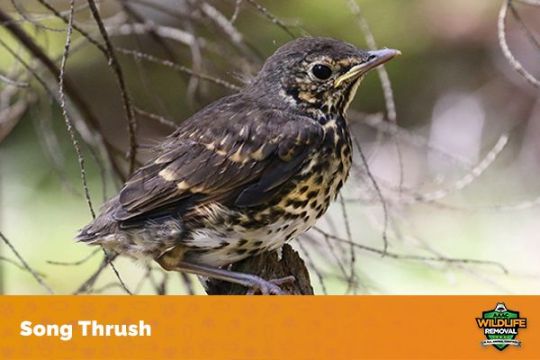
Song thrush
The song thrush is a migratory species with brown top parts and cream or buff underparts with black spots. The song thrush nests in forests, gardens, and parks. Even though it is not in danger internationally, there have been significant population losses in some regions of Europe, probably as a result of modifications to farming methods.
A whole egg from song thrushes is 31 x 22 mm in size, smooth and lustrous. They are light blue eggs with a few noticeable, sizable dark specks, mainly at the wide end.
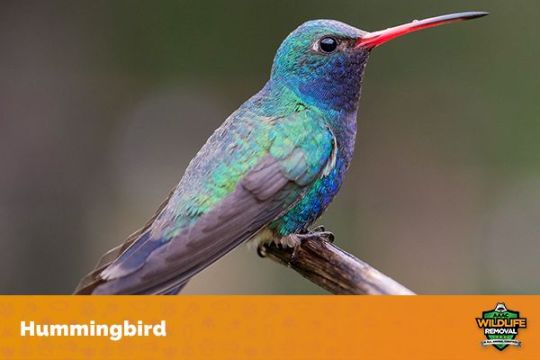
Hummingbird
The tropics are where the vast majority of Hummingbird species are found. They are little birds, with the majority of species measuring between 7.5 and 13 cm. The bee hummingbird, which measures 5 cm and weighs less than 2.0 g, is the smallest species of hummingbird still living (0.07 oz). The 23 cm enormous hummingbird, which weighs 18-24 grams, is the largest species of hummingbird. Although all species eat flying insects or spiders, they are adapted for feeding on flower nectar.
Hummingbird eggs are white and elliptical and are small eggs about the size of a small jelly bean. Most are less than a gram or the weight of a paperclip!
Blackbird
Depending on latitude, the blackbird can be resident, partially, or fully migratory. Located throughout most of Europe, it has a rich, musical singing voice. It is primarily black or dark, dark brown with yellow eyes beak. The adult female and juvenile have mostly dark brown feathers. This species builds a tidy, cup-shaped nest tied together with mud to reproduce in gardens and woods.
Blackbird eggs are pretty striking. The size of three centimeters, green, blue in color, and covered in brown dots.
Robin

The European Robin
A tiny insectivorous bird also referred to as the robin or the robin redbreast in the British Isles. The male and female are similar in color, measuring around 12.5-14.0 cm in length, with an orange breast and face bordered with grey and brown middle parts and a creamy belly. It is widespread throughout Europe, extends east to Western Siberia, and south to North Africa. They tend not to migrate, but a subset of robins do move around based on the season and latitude of their habitat.
The eggs are cream, or white with reddish-brown spots, which are frequently more prominent at the larger hemisphere of the egg.

The American robin
A songbird that migrates. Although the two species are not closely related and the European robin is a member of the Old World flycatcher family, it was named after the European robin because of its reddish-orange breast. The American robin can be found all over North America; it winters along the Pacific Coast, in southern Canada, and in central Mexico. It is the national bird of Wisconsin, Michigan, and Connecticut.
The pigment biliverdin is responsible for the blue color of robin eggs when the eggs hatch. There is evnidence that more blue the eggs appear and the healthier the female are associated with elevated biliverdin levels.
Dunnock
The dunnock is a little perching or passerine bird that lives in temperate Europe and Asian Russia. It is also known as the hedge sparrow or hedge accentor. The dunnock is brown above and has a grey breast with two dark streaks. It has a pointed bill and long legs for its size, which is around 15 cm.
A dunnock's egg is pale blue with dark brown spots, and they measure 20 x 15mm and have a matte finish.

Pheasant
Pheasants are a family of birds that includes partridges, quails, francolins, and junglefowls. The pheasant is a gamebird that is native to Asia and has been introduced to Europe, Africa, and North America. It is the national bird of Hungary. The male pheasant is very colorful with a long tail and bare red facial skin. The female is much less colorful and has a shorter tail.
Eggs from pheasants are beautiful. They have a gorgeous pale, olive-green (or occasionally brown) shell and are around half the size of a hen's egg and twice the size of a quail's egg. They have a bright yellow yolk inside.
Canada goose
The Canada goose, often known as the Canadian goose, is a sizable wild bird with a grey body, a black head and neck, white cheeks, and white beneath its chin. In addition to being frequently seen on or near freshwater, the Canada goose is also widespread in saline marshes, estuaries, and lagoons. They are herbivorous and usually migratory.
Each egg measures 2.2 inches in width and 3.3 inches in length (8.3 cm) (5.6 centimeters). The color of the eggs is a creamy white. Goslings are born with their eyes open and coated in a light yellow tint.

Mallard
The mallard, known as the wild duck, is a dabbling duck that breeds throughout the temperate and subtropical Americas, Eurasia, and North Africa. Males typically have blue speculum feathers, although both sexes have a region of white-bordered black or iridescent blue feathers on their wings. The females (hens) have mostly brown-speckled feathers, while the males have purple spots on their wings.
Eggs laid by mallard ducks can be anything from white to light blue. They can also occasionally be bluish-green. The eggs of a wild mallard are a creamy white color without any markings. Additionally, they appear as a soft blue-green.
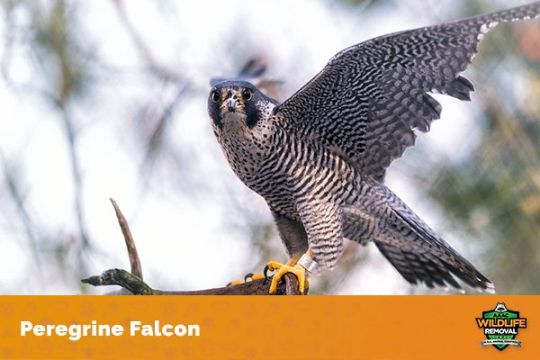
Peregrine falcon
The peregrine falcon also called duck hawk in North America, is a black head, barred white underparts, and a massive falcon with a crow-sized body. It is noted for its speed, reaching up to 320 km/h during its distinctive hunting stoop.
The Arctic tundra to the tropics is the peregrine's nesting range. Except for the most severe polar regions, extremely high mountains, and tropical rainforests. New Zealand is the only significant ice-free landmass where it is absent. It makes it one of the most ubiquitous bird species and the most common raptor worldwide.
Typically, a peregrine falcon's female lays 3 to 4 eggs with dark, reddish-brown pigment dotted throughout the eggs, slightly smaller than chicken eggs.

Herring gull
Herring gulls are medium to large seabirds. They are white with grey wings and a yellow bill with a red spot. Adults have light grey legs and feet, and their irises are dark brown. Immature gulls have pale eyes, and their legs and feet are often pinkish.
Adult herring gulls have white bodies, gray wings and backs, black wingtips, and pink legs. Unlike European herring gulls, these birds have darker tails that are gray-brown, darker, and more uniformly colored. It is frequently seen in rubbish dumps, lakes, rivers, and coastal areas. The bird typically builds a nest close to water, laying three or four eggs in a hole dug in the ground. Invertebrates, fish, and various other foods are part of its varied diet.
In shades of olive, green, or brownish-green, gull eggs blend in beautifully. While some species have browner and greener eggs, they all resemble one another. They prefer to blend in well with the mossy or rocky habitats in which they live.

Tawny owl
The tawny owl is a predatory bird of the night. Due to adaptations to its vision, hearing, and ability to fly quietly, it is able to locate and capture prey in the dark. It hunts primarily rodents, birds, and bats by ear and sound location.
The tawny owl has a round head, no ear tufts, and yellow eyes. Its upper parts are streaked brown and its underparts are pale with dark streaks. The facial disc surrounding the eyes is generally pale with a dark border.
The glossy white eggs are 48 x 39 mm in size and weigh 39.0g, which is 7% of the shell.
House martin
The common house martin, also known as the northern house martin or, more commonly, just house martin, is a migratory passerine bird of the swallow family that spends the winters in sub-Saharan Africa and tropical Asia and breeds in Europe, north Africa, and across the Palearctic. It migrates to regions with an abundance of flying insects and feeds on insects that are caught in flight. It can be found in both open areas and close to populated areas. It has a blue head and top parts, a white rump, and all-white underparts.
They hatch four to five soft, pure white eggs, average 1.9 cm by 1.33 cm in size, and weigh 1.7 g.

Great snipe
The great snipe is a wading bird in the sandpiper family. It has a very long bill and is mottled brown above with creamy-buff stripes on its flanks. The underparts are white, sometimes with a brown tinge, and there is a faint stripe over the eye. In flight, it shows a broad white wingbar.
The great snipe has a dark stripe eye and a brown body. The large wings have a light wing bar in flight. North-eastern Europe, especially north-western Russia, has marshes and wet meadows with short vegetation where the great snipe breeds. Great snipes migrate and spend their winters in Africa.
They produce olive-colored eggs with dark brown, black, or purple splotches. With a 1.4-1.7 in length and a 1.0-1.2 in width.
Chicken
The chicken is a type of domesticated jungle fowl that shares characteristics with wild species like the grey and Ceylon junglefowl, which are native to Southeast Asia. A juvenile male bird or a cockerel, and an adult male bird is known as a cock or rooster. A hen is an adult female bird.
A small hen's egg or many eggs are white and brown, but a green or bright blue egg is also possible. The shells of a chicken egg have a smooth and porous surface.
Chough
The choughs, which live in the highlands of southern Eurasia and North Africa, have black plumage with colorful legs, feet, and beaks. They fly spectacularly and have long, broad wings. Both species form lifelong pairs and show loyalty to the caves or cliff wall fissures where they nest. They consume short-grazed grassland in flocks and typically eat mostly invertebrate prey, supplemented by vegetables or food from human settlement, particularly in the winter.
They lay a few large dark speckled, cream-colored eggs. Choughs produce three to five eggs, weighing 15.7g and measuring 39-28 mm.

Cormorant
Cormorants are medium-to-large birds with a body weight of 0.35 to 5 kg and a wing span of 60 to 100 cm include cormorants and shags. Dark feathers are present in the majority of species. Each of their four toes has webbing between them. All species are fish eaters who dive from the surface to get their meal.
They are skilled divers who use their feet to move forward underwater with the assistance of their wings. Some dive as deep as 45 meters. Due to their necessity for efficient underwater movement and relatively short wings, they have one of the most calorically expensive flights of any flying bird.
They lay unmarked pale blue eggs measuring 5.6-7 cm in length and 3.5-4 cm in width.

Osprey
The fish-eating, nocturnal osprey, also known as the sea hawk, river hawk, and fish hawk, has a wide geographic range. It is a sizable raptor that can grow to be more than 60 cm long and 180 cm across the wings. The head and underparts are primarily greyish, while the upper parts are brown.
The eggs laid are mottled or speckled with red or dark brown, ranging in color from dirty white to light brown. The eggs are about the size of chicken eggs and weigh 60-80gm each. The first egg is the largest, and the next ones get smaller one or two days later.
Emu
The emu is the second-tallest living big bird after the ostrich. Emus are brown, flightless birds with soft feathers that may grow up to 1.9 meters in height. They also have long necks and legs. Emus go for weeks without eating, although they can travel enormous distances and sprint at 48 km/h when necessary.
Emu lays eggs in an intense green shade with blueish tones. The natural pigment progressively fades with exposure to light, changing the color of the surface to a greyish brown. Emu eggs range in size from 400 to 700 grams and are typically about 13 x 9 cm.

Ostrich
The ratites, including ostritches, emus, rheas, and kiwis, are a diversified group of giant flightless birds.. The common ostrich and the Somali ostrich are the only two species of ostrich that exist today. They are indigenous to Africa. They can run at 70 km/h, making them the quickest birds on land. They are raised worldwide, especially for their feathers which are used as dusters and ornaments. Additionally, their skin is used to make leather goods. The fact that ostriches are the heaviest living birds is noteworthy.
An ostrich egg is a massive, with an egg size measuring 15 cm long, 13 cm wide, and weighing 1.4 kg, on average. The shell is 1-2 mm thick and has a porosity of about 70%. They are spherical and smooth with a glossy surface.
Birds Nesting On Your Gutter or Vent? We'll Remove Them For You!
If you need help with birds and their nesting or other animals on your property, AAAC Wildlife Removal is here to help. We are experts in the field of animal and bird removal, and we can get rid of any problem you may have. We also offer a variety of other services to keep your home or business free of pests. Contact us today to learn more!
Conclusion
Well, that was quite a list! As you can see, many different types of birds and their eggs are as diverse as they are. Some are small and some are large. Some are colorful and some are not. But they all have one thing in common- they are all amazing!
So, the next time you see a bird, take a moment to appreciate all that it is and all that it does. And if you're ever in the market for bird removal services, be sure to give AAAC Wildlife Removal a call! We would be more than happy to help you out!
Locally Published on: https://san-diego.aaacwildliferemoval.com/blog/birds/birds-and-their-eggs/
0 notes
Text
Birds And Their Eggs
There are so many different types of birds: Waterfowl (Anseriformes), Birds of Prey (Accipitriformes), Hummingbirds (Apodiformes), Nightjars (Caprimulgiformes)... The list goes on and on! But have you ever wondered what their eggs look like?
Let's explore the types of birds and their eggs.
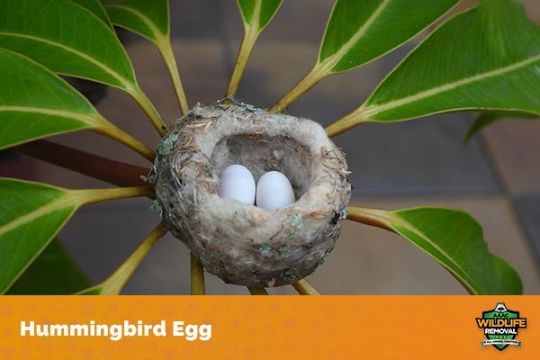
How to identify birds' eggs
Identifying bird’s eggs can be tricky, even for experienced birders. But with a bit of practice, you'll be able to tell the difference between the eggs of many birds.
The first step in identifying a bird's egg is determining its size. Bird eggs come in all different sizes, from tiny hummingbird eggs to huge ostrich eggs. Take a look at the color, Bird eggs can be white, blue, green, brown, or any combination of these colors. Finally, there are usually markings. Some eggs have spots, while others have different markings.
That's probably the basics of identifying eggs. And now let's know more about the birds and their eggs.

Great tit
The great tit is a recognizable bird with a black head and neck, prominent white cheeks, olive upperparts, and yellow underparts. In the summer, it mainly eats insects. In the winter, it will consume a wider variety of foods, including little bats that are hibernating.
Great tit eggs measure 17.5 x 13.5mm and have a slight sheen. They have varying degrees of reddish or purplish speckling over their white background.

Starling
In addition to northern Australia and the islands of the tropical Pacific, starlings are endemic to Europe, Asia, and Africa. Many species from Europe and Asia have been imported to these regions, as well as to North America, Hawaii, and New Zealand. They are regarded as invasive species because they frequently compete with native birds for habitat. The common starling is the species most people in Europe and North America are familiar with.
Starlings are exceedingly sociable, with powerful feet, and a strong, direct flight. They eat insects and fruit and enjoy an open, rural environment for their habitat. Many creatures that dwell close to human settlements are essentially omnivores.
Sized at 30 x 21 mm, starling eggshells are smooth and relatively glossy. They are typically pale blue-green bird eggs.
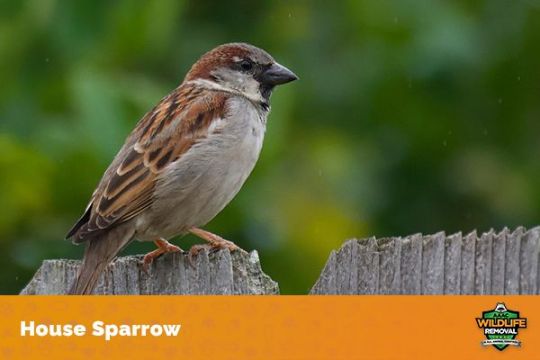
House sparrow
Male house sparrows have more vivid black, white, and brown markings whereas females and young birds are colored a light brown and grey. Native to much of Asia, the Mediterranean region, and most of Europe. It is the most extensively dispersed wild bird due to its deliberate or unintentional imports to numerous areas, including sections of Australasia, Africa, and the Americas.
The house sparrow, which can be found in both urban and rural areas, is closely related to human habitation. Although it can be found in a broad variety of habitats and climates, it normally stays away from vast woodlands, meadows, and deserts that are not well developed by humans. Although it is an opportunistic eater and frequently consumes insects and a variety of other things, it primarily consumes the seeds of weeds and grains.
House sparrow hatching eggs are slightly glossy, 22.5 x 15.5 mm eggs. White with variable amounts of dark brown and blue-grey speckling.
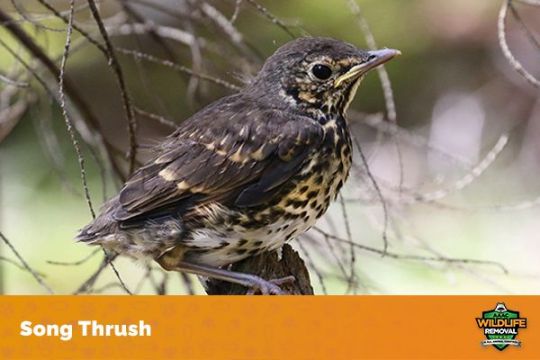
Song thrush
The song thrush is a migratory species with brown top parts and cream or buff underparts with black spots. The song thrush nests in forests, gardens, and parks. Even though it is not in danger internationally, there have been significant population losses in some regions of Europe, probably as a result of modifications to farming methods.
A whole egg from song thrushes is 31 x 22 mm in size, smooth and lustrous. They are light blue eggs with a few noticeable, sizable dark specks, mainly at the wide end.

Hummingbird
The tropics are where the vast majority of Hummingbird species are found. They are little birds, with the majority of species measuring between 7.5 and 13 cm. The bee hummingbird, which measures 5 cm and weighs less than 2.0 g, is the smallest species of hummingbird still living (0.07 oz). The 23 cm enormous hummingbird, which weighs 18-24 grams, is the largest species of hummingbird. Although all species eat flying insects or spiders, they are adapted for feeding on flower nectar.
Hummingbird eggs are white and elliptical and are small eggs about the size of a small jelly bean. Most are less than a gram or the weight of a paperclip!
Blackbird
Depending on latitude, the blackbird can be resident, partially, or fully migratory. Located throughout most of Europe, it has a rich, musical singing voice. It is primarily black or dark, dark brown with yellow eyes beak. The adult female and juvenile have mostly dark brown feathers. This species builds a tidy, cup-shaped nest tied together with mud to reproduce in gardens and woods.
Blackbird eggs are pretty striking. The size of three centimeters, green, blue in color, and covered in brown dots.
Robin

The European Robin
A tiny insectivorous bird also referred to as the robin or the robin redbreast in the British Isles. The male and female are similar in color, measuring around 12.5-14.0 cm in length, with an orange breast and face bordered with grey and brown middle parts and a creamy belly. It is widespread throughout Europe, extends east to Western Siberia, and south to North Africa. They tend not to migrate, but a subset of robins do move around based on the season and latitude of their habitat.
The eggs are cream, or white with reddish-brown spots, which are frequently more prominent at the larger hemisphere of the egg.
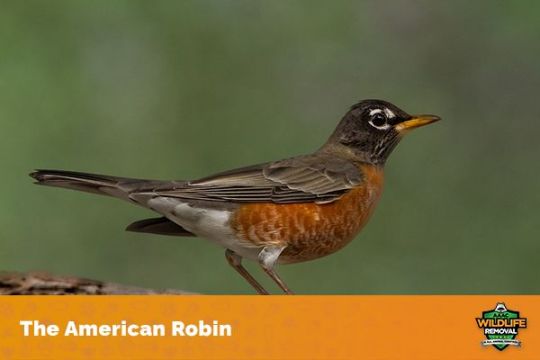
The American robin
A songbird that migrates. Although the two species are not closely related and the European robin is a member of the Old World flycatcher family, it was named after the European robin because of its reddish-orange breast. The American robin can be found all over North America; it winters along the Pacific Coast, in southern Canada, and in central Mexico. It is the national bird of Wisconsin, Michigan, and Connecticut.
The pigment biliverdin is responsible for the blue color of robin eggs when the eggs hatch. There is evnidence that more blue the eggs appear and the healthier the female are associated with elevated biliverdin levels.
Dunnock
The dunnock is a little perching or passerine bird that lives in temperate Europe and Asian Russia. It is also known as the hedge sparrow or hedge accentor. The dunnock is brown above and has a grey breast with two dark streaks. It has a pointed bill and long legs for its size, which is around 15 cm.
A dunnock's egg is pale blue with dark brown spots, and they measure 20 x 15mm and have a matte finish.
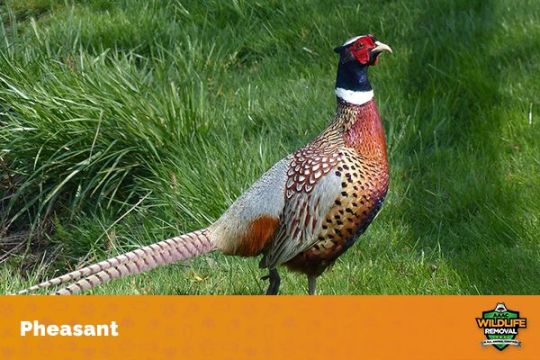
Pheasant
Pheasants are a family of birds that includes partridges, quails, francolins, and junglefowls. The pheasant is a gamebird that is native to Asia and has been introduced to Europe, Africa, and North America. It is the national bird of Hungary. The male pheasant is very colorful with a long tail and bare red facial skin. The female is much less colorful and has a shorter tail.
Eggs from pheasants are beautiful. They have a gorgeous pale, olive-green (or occasionally brown) shell and are around half the size of a hen's egg and twice the size of a quail's egg. They have a bright yellow yolk inside.
Canada goose
The Canada goose, often known as the Canadian goose, is a sizable wild bird with a grey body, a black head and neck, white cheeks, and white beneath its chin. In addition to being frequently seen on or near freshwater, the Canada goose is also widespread in saline marshes, estuaries, and lagoons. They are herbivorous and usually migratory.
Each egg measures 2.2 inches in width and 3.3 inches in length (8.3 cm) (5.6 centimeters). The color of the eggs is a creamy white. Goslings are born with their eyes open and coated in a light yellow tint.

Mallard
The mallard, known as the wild duck, is a dabbling duck that breeds throughout the temperate and subtropical Americas, Eurasia, and North Africa. Males typically have blue speculum feathers, although both sexes have a region of white-bordered black or iridescent blue feathers on their wings. The females (hens) have mostly brown-speckled feathers, while the males have purple spots on their wings.
Eggs laid by mallard ducks can be anything from white to light blue. They can also occasionally be bluish-green. The eggs of a wild mallard are a creamy white color without any markings. Additionally, they appear as a soft blue-green.

Peregrine falcon
The peregrine falcon also called duck hawk in North America, is a black head, barred white underparts, and a massive falcon with a crow-sized body. It is noted for its speed, reaching up to 320 km/h during its distinctive hunting stoop.
The Arctic tundra to the tropics is the peregrine's nesting range. Except for the most severe polar regions, extremely high mountains, and tropical rainforests. New Zealand is the only significant ice-free landmass where it is absent. It makes it one of the most ubiquitous bird species and the most common raptor worldwide.
Typically, a peregrine falcon's female lays 3 to 4 eggs with dark, reddish-brown pigment dotted throughout the eggs, slightly smaller than chicken eggs.
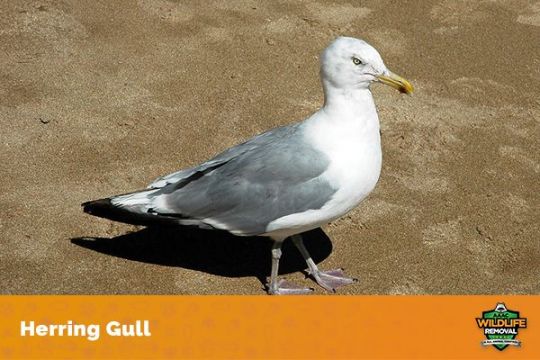
Herring gull
Herring gulls are medium to large seabirds. They are white with grey wings and a yellow bill with a red spot. Adults have light grey legs and feet, and their irises are dark brown. Immature gulls have pale eyes, and their legs and feet are often pinkish.
Adult herring gulls have white bodies, gray wings and backs, black wingtips, and pink legs. Unlike European herring gulls, these birds have darker tails that are gray-brown, darker, and more uniformly colored. It is frequently seen in rubbish dumps, lakes, rivers, and coastal areas. The bird typically builds a nest close to water, laying three or four eggs in a hole dug in the ground. Invertebrates, fish, and various other foods are part of its varied diet.
In shades of olive, green, or brownish-green, gull eggs blend in beautifully. While some species have browner and greener eggs, they all resemble one another. They prefer to blend in well with the mossy or rocky habitats in which they live.

Tawny owl
The tawny owl is a predatory bird of the night. Due to adaptations to its vision, hearing, and ability to fly quietly, it is able to locate and capture prey in the dark. It hunts primarily rodents, birds, and bats by ear and sound location.
The tawny owl has a round head, no ear tufts, and yellow eyes. Its upper parts are streaked brown and its underparts are pale with dark streaks. The facial disc surrounding the eyes is generally pale with a dark border.
The glossy white eggs are 48 x 39 mm in size and weigh 39.0g, which is 7% of the shell.
House martin
The common house martin, also known as the northern house martin or, more commonly, just house martin, is a migratory passerine bird of the swallow family that spends the winters in sub-Saharan Africa and tropical Asia and breeds in Europe, north Africa, and across the Palearctic. It migrates to regions with an abundance of flying insects and feeds on insects that are caught in flight. It can be found in both open areas and close to populated areas. It has a blue head and top parts, a white rump, and all-white underparts.
They hatch four to five soft, pure white eggs, average 1.9 cm by 1.33 cm in size, and weigh 1.7 g.

Great snipe
The great snipe is a wading bird in the sandpiper family. It has a very long bill and is mottled brown above with creamy-buff stripes on its flanks. The underparts are white, sometimes with a brown tinge, and there is a faint stripe over the eye. In flight, it shows a broad white wingbar.
The great snipe has a dark stripe eye and a brown body. The large wings have a light wing bar in flight. North-eastern Europe, especially north-western Russia, has marshes and wet meadows with short vegetation where the great snipe breeds. Great snipes migrate and spend their winters in Africa.
They produce olive-colored eggs with dark brown, black, or purple splotches. With a 1.4-1.7 in length and a 1.0-1.2 in width.
Chicken
The chicken is a type of domesticated jungle fowl that shares characteristics with wild species like the grey and Ceylon junglefowl, which are native to Southeast Asia. A juvenile male bird or a cockerel, and an adult male bird is known as a cock or rooster. A hen is an adult female bird.
A small hen's egg or many eggs are white and brown, but a green or bright blue egg is also possible. The shells of a chicken egg have a smooth and porous surface.
Chough
The choughs, which live in the highlands of southern Eurasia and North Africa, have black plumage with colorful legs, feet, and beaks. They fly spectacularly and have long, broad wings. Both species form lifelong pairs and show loyalty to the caves or cliff wall fissures where they nest. They consume short-grazed grassland in flocks and typically eat mostly invertebrate prey, supplemented by vegetables or food from human settlement, particularly in the winter.
They lay a few large dark speckled, cream-colored eggs. Choughs produce three to five eggs, weighing 15.7g and measuring 39-28 mm.
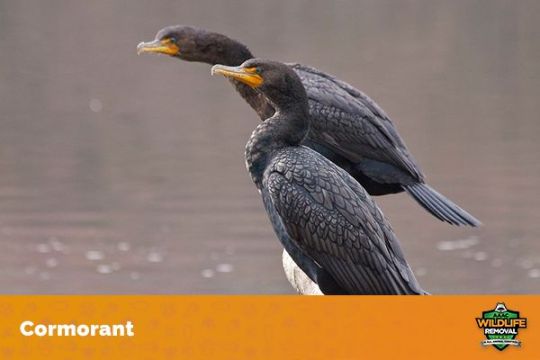
Cormorant
Cormorants are medium-to-large birds with a body weight of 0.35 to 5 kg and a wing span of 60 to 100 cm include cormorants and shags. Dark feathers are present in the majority of species. Each of their four toes has webbing between them. All species are fish eaters who dive from the surface to get their meal.
They are skilled divers who use their feet to move forward underwater with the assistance of their wings. Some dive as deep as 45 meters. Due to their necessity for efficient underwater movement and relatively short wings, they have one of the most calorically expensive flights of any flying bird.
They lay unmarked pale blue eggs measuring 5.6-7 cm in length and 3.5-4 cm in width.
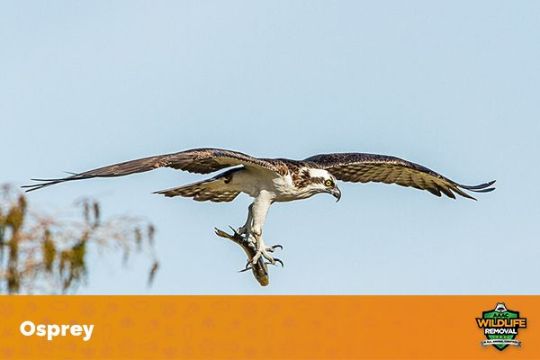
Osprey
The fish-eating, nocturnal osprey, also known as the sea hawk, river hawk, and fish hawk, has a wide geographic range. It is a sizable raptor that can grow to be more than 60 cm long and 180 cm across the wings. The head and underparts are primarily greyish, while the upper parts are brown.
The eggs laid are mottled or speckled with red or dark brown, ranging in color from dirty white to light brown. The eggs are about the size of chicken eggs and weigh 60-80gm each. The first egg is the largest, and the next ones get smaller one or two days later.
Emu
The emu is the second-tallest living big bird after the ostrich. Emus are brown, flightless birds with soft feathers that may grow up to 1.9 meters in height. They also have long necks and legs. Emus go for weeks without eating, although they can travel enormous distances and sprint at 48 km/h when necessary.
Emu lays eggs in an intense green shade with blueish tones. The natural pigment progressively fades with exposure to light, changing the color of the surface to a greyish brown. Emu eggs range in size from 400 to 700 grams and are typically about 13 x 9 cm.

Ostrich
The ratites, including ostritches, emus, rheas, and kiwis, are a diversified group of giant flightless birds.. The common ostrich and the Somali ostrich are the only two species of ostrich that exist today. They are indigenous to Africa. They can run at 70 km/h, making them the quickest birds on land. They are raised worldwide, especially for their feathers which are used as dusters and ornaments. Additionally, their skin is used to make leather goods. The fact that ostriches are the heaviest living birds is noteworthy.
An ostrich egg is a massive, with an egg size measuring 15 cm long, 13 cm wide, and weighing 1.4 kg, on average. The shell is 1-2 mm thick and has a porosity of about 70%. They are spherical and smooth with a glossy surface.
Birds Nesting On Your Gutter or Vent? We'll Remove Them For You!
If you need help with birds and their nesting or other animals on your property, AAAC Wildlife Removal is here to help. We are experts in the field of animal and bird removal, and we can get rid of any problem you may have. We also offer a variety of other services to keep your home or business free of pests. Contact us today to learn more!
Conclusion
Well, that was quite a list! As you can see, many different types of birds and their eggs are as diverse as they are. Some are small and some are large. Some are colorful and some are not. But they all have one thing in common- they are all amazing!
So, the next time you see a bird, take a moment to appreciate all that it is and all that it does. And if you're ever in the market for bird removal services, be sure to give AAAC Wildlife Removal a call! We would be more than happy to help you out!
Locally Published on: https://salt-lake-city.aaacwildliferemoval.com/blog/birds/birds-and-their-eggs/
0 notes
Text
Birds And Their Eggs
There are so many different types of birds: Waterfowl (Anseriformes), Birds of Prey (Accipitriformes), Hummingbirds (Apodiformes), Nightjars (Caprimulgiformes)... The list goes on and on! But have you ever wondered what their eggs look like?
Let's explore the types of birds and their eggs.

How to identify birds' eggs
Identifying bird’s eggs can be tricky, even for experienced birders. But with a bit of practice, you'll be able to tell the difference between the eggs of many birds.
The first step in identifying a bird's egg is determining its size. Bird eggs come in all different sizes, from tiny hummingbird eggs to huge ostrich eggs. Take a look at the color, Bird eggs can be white, blue, green, brown, or any combination of these colors. Finally, there are usually markings. Some eggs have spots, while others have different markings.
That's probably the basics of identifying eggs. And now let's know more about the birds and their eggs.

Great tit
The great tit is a recognizable bird with a black head and neck, prominent white cheeks, olive upperparts, and yellow underparts. In the summer, it mainly eats insects. In the winter, it will consume a wider variety of foods, including little bats that are hibernating.
Great tit eggs measure 17.5 x 13.5mm and have a slight sheen. They have varying degrees of reddish or purplish speckling over their white background.
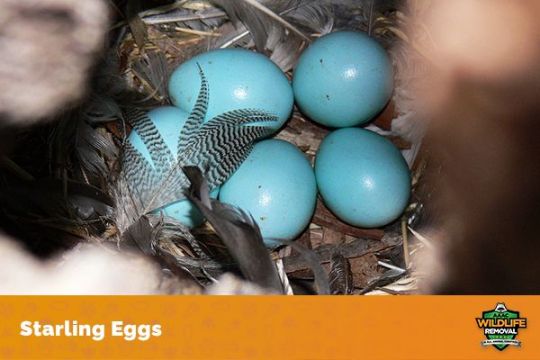
Starling
In addition to northern Australia and the islands of the tropical Pacific, starlings are endemic to Europe, Asia, and Africa. Many species from Europe and Asia have been imported to these regions, as well as to North America, Hawaii, and New Zealand. They are regarded as invasive species because they frequently compete with native birds for habitat. The common starling is the species most people in Europe and North America are familiar with.
Starlings are exceedingly sociable, with powerful feet, and a strong, direct flight. They eat insects and fruit and enjoy an open, rural environment for their habitat. Many creatures that dwell close to human settlements are essentially omnivores.
Sized at 30 x 21 mm, starling eggshells are smooth and relatively glossy. They are typically pale blue-green bird eggs.
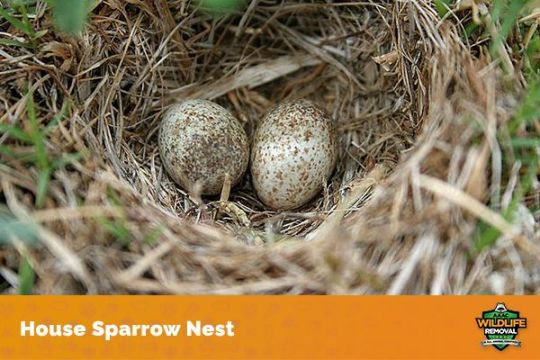
House sparrow
Male house sparrows have more vivid black, white, and brown markings whereas females and young birds are colored a light brown and grey. Native to much of Asia, the Mediterranean region, and most of Europe. It is the most extensively dispersed wild bird due to its deliberate or unintentional imports to numerous areas, including sections of Australasia, Africa, and the Americas.
The house sparrow, which can be found in both urban and rural areas, is closely related to human habitation. Although it can be found in a broad variety of habitats and climates, it normally stays away from vast woodlands, meadows, and deserts that are not well developed by humans. Although it is an opportunistic eater and frequently consumes insects and a variety of other things, it primarily consumes the seeds of weeds and grains.
House sparrow hatching eggs are slightly glossy, 22.5 x 15.5 mm eggs. White with variable amounts of dark brown and blue-grey speckling.

Song thrush
The song thrush is a migratory species with brown top parts and cream or buff underparts with black spots. The song thrush nests in forests, gardens, and parks. Even though it is not in danger internationally, there have been significant population losses in some regions of Europe, probably as a result of modifications to farming methods.
A whole egg from song thrushes is 31 x 22 mm in size, smooth and lustrous. They are light blue eggs with a few noticeable, sizable dark specks, mainly at the wide end.
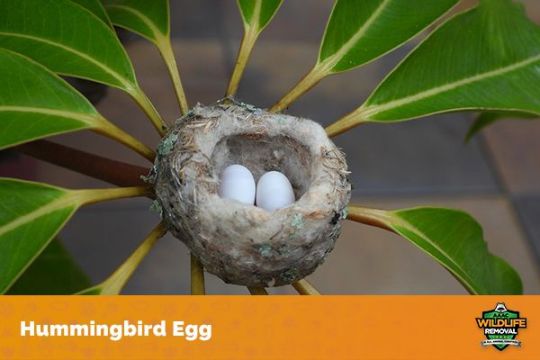
Hummingbird
The tropics are where the vast majority of Hummingbird species are found. They are little birds, with the majority of species measuring between 7.5 and 13 cm. The bee hummingbird, which measures 5 cm and weighs less than 2.0 g, is the smallest species of hummingbird still living (0.07 oz). The 23 cm enormous hummingbird, which weighs 18-24 grams, is the largest species of hummingbird. Although all species eat flying insects or spiders, they are adapted for feeding on flower nectar.
Hummingbird eggs are white and elliptical and are small eggs about the size of a small jelly bean. Most are less than a gram or the weight of a paperclip!
Blackbird
Depending on latitude, the blackbird can be resident, partially, or fully migratory. Located throughout most of Europe, it has a rich, musical singing voice. It is primarily black or dark, dark brown with yellow eyes beak. The adult female and juvenile have mostly dark brown feathers. This species builds a tidy, cup-shaped nest tied together with mud to reproduce in gardens and woods.
Blackbird eggs are pretty striking. The size of three centimeters, green, blue in color, and covered in brown dots.
Robin
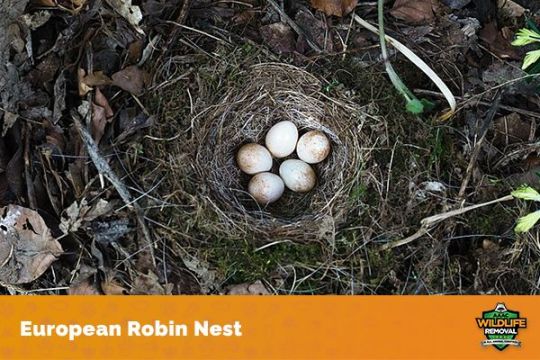
The European Robin
A tiny insectivorous bird also referred to as the robin or the robin redbreast in the British Isles. The male and female are similar in color, measuring around 12.5-14.0 cm in length, with an orange breast and face bordered with grey and brown middle parts and a creamy belly. It is widespread throughout Europe, extends east to Western Siberia, and south to North Africa. They tend not to migrate, but a subset of robins do move around based on the season and latitude of their habitat.
The eggs are cream, or white with reddish-brown spots, which are frequently more prominent at the larger hemisphere of the egg.
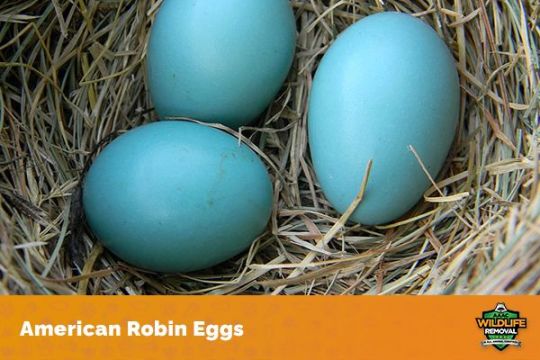
The American robin
A songbird that migrates. Although the two species are not closely related and the European robin is a member of the Old World flycatcher family, it was named after the European robin because of its reddish-orange breast. The American robin can be found all over North America; it winters along the Pacific Coast, in southern Canada, and in central Mexico. It is the national bird of Wisconsin, Michigan, and Connecticut.
The pigment biliverdin is responsible for the blue color of robin eggs when the eggs hatch. There is evidence that the more blue the eggs appear and the healthier the female are associated with elevated biliverdin levels.
Dunnock
The dunnock is a little perching or passerine bird that lives in temperate Europe and Asian Russia. It is also known as the hedge sparrow or hedge accentor. The dunnock is brown above and has a grey breast with two dark streaks. It has a pointed bill and long legs for its size, which is around 15 cm.
A dunnock's egg is pale blue with dark brown spots, and they measure 20 x 15mm and have a matte finish.

Pheasant
Pheasants are a family of birds that includes partridges, quails, francolins, and junglefowls. The pheasant is a gamebird that is native to Asia and has been introduced to Europe, Africa, and North America. It is the national bird of Hungary. The male pheasant is very colorful with a long tail and bare red facial skin. The female is much less colorful and has a shorter tail.
Eggs from pheasants are beautiful. They have a gorgeous pale, olive-green (or occasionally brown) shell and are around half the size of a hen's egg and twice the size of a quail's egg. They have a bright yellow yolk inside.
Canada goose
The Canada goose, often known as the Canadian goose, is a sizable wild bird with a grey body, a black head and neck, white cheeks, and white beneath its chin. In addition to being frequently seen on or near freshwater, the Canada goose is also widespread in saline marshes, estuaries, and lagoons. They are herbivorous and usually migratory.
Each egg measures 2.2 inches in width and 3.3 inches in length (8.3 cm) (5.6 centimeters). The color of the eggs is a creamy white. Goslings are born with their eyes open and coated in a light yellow tint.
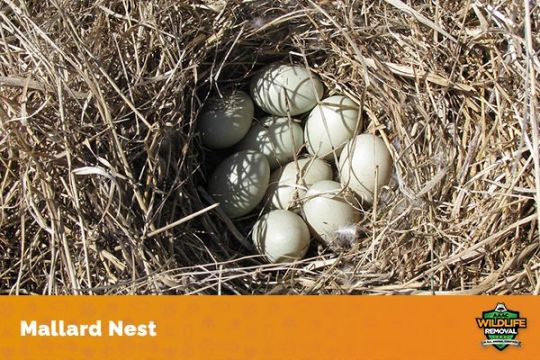
Mallard
The mallard, known as the wild duck, is a dabbling duck that breeds throughout the temperate and subtropical Americas, Eurasia, and North Africa. Males typically have blue speculum feathers, although both sexes have a region of white-bordered black or iridescent blue feathers on their wings. The females (hens) have mostly brown-speckled feathers, while the males have purple spots on their wings.
Eggs laid by mallard ducks can be anything from white to light blue. They can also occasionally be bluish-green. The eggs of a wild mallard are a creamy white color without any markings. Additionally, they appear as a soft blue-green.

Peregrine falcon
The peregrine falcon also called duck hawk in North America, is a black head, barred white underparts, and a massive falcon with a crow-sized body. It is noted for its speed, reaching up to 320 km/h during its distinctive hunting stoop.
The Arctic tundra to the tropics is the peregrine's nesting range. Except for the most severe polar regions, extremely high mountains, and tropical rainforests. New Zealand is the only significant ice-free landmass where it is absent. It makes it one of the most ubiquitous bird species and the most common raptor worldwide.
Typically, a peregrine falcon's female lays 3 to 4 eggs with dark, reddish-brown pigment dotted throughout the eggs, slightly smaller than chicken eggs.
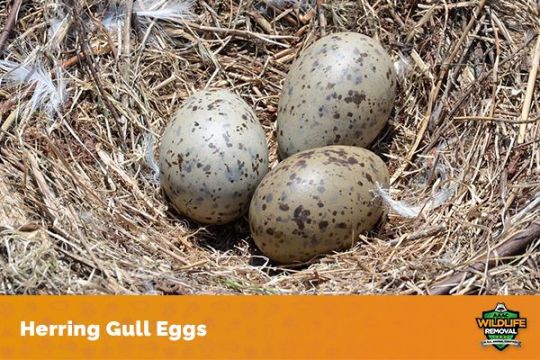
Herring gull
Herring gulls are medium to large seabirds. They are white with grey wings and a yellow bill with a red spot. Adults have light grey legs and feet, and their irises are dark brown. Immature gulls have pale eyes, and their legs and feet are often pinkish.
Adult herring gulls have white bodies, gray wings and backs, black wingtips, and pink legs. Unlike European herring gulls, these birds have darker tails that are gray-brown, darker, and more uniformly colored. It is frequently seen in rubbish dumps, lakes, rivers, and coastal areas. The bird typically builds a nest close to water, laying three or four eggs in a hole dug in the ground. Invertebrates, fish, and various other foods are part of its varied diet.
In shades of olive, green, or brownish-green, gull eggs blend in beautifully. While some species have browner and greener eggs, they all resemble one another. They prefer to blend in well with the mossy or rocky habitats in which they live.
Tawny owl
The tawny owl is a predatory bird of the night. Due to adaptations to its vision, hearing, and ability to fly quietly, it is able to locate and capture prey in the dark. It hunts primarily rodents, birds, and bats by ear and sound location.
The tawny owl has a round head, no ear tufts, and yellow eyes. Its upper parts are streaked brown and its underparts are pale with dark streaks. The facial disc surrounding the eyes is generally pale with a dark border.
The glossy white eggs are 48 x 39 mm in size and weigh 39.0g, which is 7% of the shell.

House martin
The common house martin, also known as the northern house martin or, more commonly, just house martin, is a migratory passerine bird of the swallow family that spends the winters in sub-Saharan Africa and tropical Asia and breeds in Europe, north Africa, and across the Palearctic. It migrates to regions with an abundance of flying insects and feeds on insects that are caught in flight. It can be found in both open areas and close to populated areas. It has a blue head and top parts, a white rump, and all-white underparts.
They hatch four to five soft, pure white eggs, average 1.9 cm by 1.33 cm in size, and weigh 1.7 g.

Great snipe
The great snipe is a wading bird in the sandpiper family. It has a very long bill and is mottled brown above with creamy-buff stripes on its flanks. The underparts are white, sometimes with a brown tinge, and there is a faint stripe over the eye. In flight, it shows a broad white wingbar.
The great snipe has a dark stripe eye and a brown body. The large wings have a light wing bar in flight. North-eastern Europe, especially north-western Russia, has marshes and wet meadows with short vegetation where the great snipe breeds. Great snipes migrate and spend their winters in Africa.
They produce olive-colored eggs with dark brown, black, or purple splotches. With a 1.4-1.7 in length and a 1.0-1.2 in width.
Chicken
The chicken is a type of domesticated jungle fowl that shares characteristics with wild species like the grey and Ceylon junglefowl, which are native to Southeast Asia. A juvenile male bird or a cockerel, and an adult male bird is known as a cock or rooster. A hen is an adult female bird.
A small hen's egg or many eggs are white and brown, but a green or bright blue egg is also possible. The shells of a chicken egg have a smooth and porous surface.
Chough
The choughs, which live in the highlands of southern Eurasia and North Africa, have black plumage with colorful legs, feet, and beaks. They fly spectacularly and have long, broad wings. Both species form lifelong pairs and show loyalty to the caves or cliff wall fissures where they nest. They consume short-grazed grassland in flocks and typically eat mostly invertebrate prey, supplemented by vegetables or food from human settlement, particularly in the winter.
They lay a few large dark speckled, cream-colored eggs. Choughs produce three to five eggs, weighing 15.7g and measuring 39-28 mm.
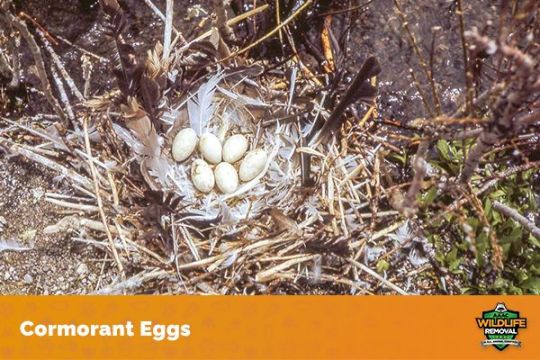
Cormorant
Cormorants are medium-to-large birds with a body weight of 0.35 to 5 kg and a wing span of 60 to 100 cm include cormorants and shags. Dark feathers are present in the majority of species. Each of their four toes has webbing between them. All species are fish eaters who dive from the surface to get their meal.
They are skilled divers who use their feet to move forward underwater with the assistance of their wings. Some dive as deep as 45 meters. Due to their necessity for efficient underwater movement and relatively short wings, they have one of the most calorically expensive flights of any flying bird.
They lay unmarked pale blue eggs measuring 5.6-7 cm in length and 3.5-4 cm in width.

Osprey
The fish-eating, nocturnal osprey, also known as the sea hawk, river hawk, and fish hawk, has a wide geographic range. It is a sizable raptor that can grow to be more than 60 cm long and 180 cm across the wings. The head and underparts are primarily greyish, while the upper parts are brown.
The eggs laid are mottled or speckled with red or dark brown, ranging in color from dirty white to light brown. The eggs are about the size of chicken eggs and weigh 60-80gm each. The first egg is the largest, and the next ones get smaller one or two days later.
Emu
The emu is the second-tallest living big bird after the ostrich. Emus are brown, flightless birds with soft feathers that may grow up to 1.9 meters in height. They also have long necks and legs. Emus go for weeks without eating, although they can travel enormous distances and sprint at 48 km/h when necessary.
Emu lays eggs in an intense green shade with blueish tones. The natural pigment progressively fades with exposure to light, changing the color of the surface to a greyish brown. Emu eggs range in size from 400 to 700 grams and are typically about 13 x 9 cm.

Ostrich
The ratites, including ostritches, emus, rheas, and kiwis, are a diversified group of giant flightless birds.. The common ostrich and the Somali ostrich are the only two species of ostrich that exist today. They are indigenous to Africa. They can run at 70 km/h, making them the quickest birds on land. They are raised worldwide, especially for their feathers which are used as dusters and ornaments. Additionally, their skin is used to make leather goods. The fact that ostriches are the heaviest living birds is noteworthy.
An ostrich egg is a massive, with an egg size measuring 15 cm long, 13 cm wide, and weighing 1.4 kg, on average. The shell is 1-2 mm thick and has a porosity of about 70%. They are spherical and smooth with a glossy surface.
Birds Nesting On Your Gutter or Vent? We'll Remove Them For You!
If you need help with birds and their nesting or other animals on your property, AAAC Wildlife Removal is here to help. We are experts in the field of animal and bird removal, and we can get rid of any problem you may have. We also offer a variety of other services to keep your home or business free of pests. Contact us today to learn more!
Conclusion
Well, that was quite a list! As you can see, many different types of birds and their eggs are as diverse as they are. Some are small and some are large. Some are colorful and some are not. But they all have one thing in common- they are all amazing!
So, the next time you see a bird, take a moment to appreciate all that it is and all that it does. And if you're ever in the market for bird removal services, be sure to give AAAC Wildlife Removal a call! We would be more than happy to help you out!
Locally Published on: https://houston.aaacwildliferemoval.com/blog/birds/birds-and-their-eggs/
0 notes
Text
Birds And Their Eggs
There are so many different types of birds: Waterfowl (Anseriformes), Birds of Prey (Accipitriformes), Hummingbirds (Apodiformes), Nightjars (Caprimulgiformes)... The list goes on and on! But have you ever wondered what their eggs look like?
Let's explore the types of birds and their eggs.
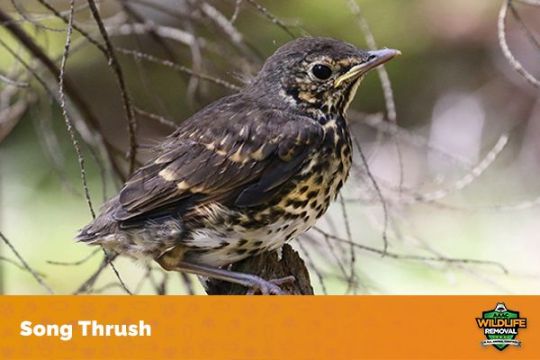
How to identify birds' eggs
Identifying bird’s eggs can be tricky, even for experienced birders. But with a bit of practice, you'll be able to tell the difference between the eggs of many birds.
The first step in identifying a bird's egg is determining its size. Bird eggs come in all different sizes, from tiny hummingbird eggs to huge ostrich eggs. Take a look at the color, Bird eggs can be white, blue, green, brown, or any combination of these colors. Finally, there are usually markings. Some eggs have spots, while others have different markings.
That's probably the basics of identifying eggs. And now let's know more about the birds and their eggs.

Great tit
The great tit is a recognizable bird with a black head and neck, prominent white cheeks, olive upperparts, and yellow underparts. In the summer, it mainly eats insects. In the winter, it will consume a wider variety of foods, including little bats that are hibernating.
Great tit eggs measure 17.5 x 13.5mm and have a slight sheen. They have varying degrees of reddish or purplish speckling over their white background.

Starling
In addition to northern Australia and the islands of the tropical Pacific, starlings are endemic to Europe, Asia, and Africa. Many species from Europe and Asia have been imported to these regions, as well as to North America, Hawaii, and New Zealand. They are regarded as invasive species because they frequently compete with native birds for habitat. The common starling is the species most people in Europe and North America are familiar with.
Starlings are exceedingly sociable, with powerful feet, and a strong, direct flight. They eat insects and fruit and enjoy an open, rural environment for their habitat. Many creatures that dwell close to human settlements are essentially omnivores.
Sized at 30 x 21 mm, starling eggshells are smooth and relatively glossy. They are typically pale blue-green bird eggs.

House sparrow
Male house sparrows have more vivid black, white, and brown markings whereas females and young birds are colored a light brown and grey. Native to much of Asia, the Mediterranean region, and most of Europe. It is the most extensively dispersed wild bird due to its deliberate or unintentional imports to numerous areas, including sections of Australasia, Africa, and the Americas.
The house sparrow, which can be found in both urban and rural areas, is closely related to human habitation. Although it can be found in a broad variety of habitats and climates, it normally stays away from vast woodlands, meadows, and deserts that are not well developed by humans. Although it is an opportunistic eater and frequently consumes insects and a variety of other things, it primarily consumes the seeds of weeds and grains.
House sparrow hatching eggs are slightly glossy, 22.5 x 15.5 mm eggs. White with variable amounts of dark brown and blue-grey speckling.

Song thrush
The song thrush is a migratory species with brown top parts and cream or buff underparts with black spots. The song thrush nests in forests, gardens, and parks. Even though it is not in danger internationally, there have been significant population losses in some regions of Europe, probably as a result of modifications to farming methods.
A whole egg from song thrushes is 31 x 22 mm in size, smooth and lustrous. They are light blue eggs with a few noticeable, sizable dark specks, mainly at the wide end.

Hummingbird
The tropics are where the vast majority of Hummingbird species are found. They are little birds, with the majority of species measuring between 7.5 and 13 cm. The bee hummingbird, which measures 5 cm and weighs less than 2.0 g, is the smallest species of hummingbird still living (0.07 oz). The 23 cm enormous hummingbird, which weighs 18-24 grams, is the largest species of hummingbird. Although all species eat flying insects or spiders, they are adapted for feeding on flower nectar.
Hummingbird eggs are white and elliptical and are small eggs about the size of a small jelly bean. Most are less than a gram or the weight of a paperclip!
Blackbird
Depending on latitude, the blackbird can be resident, partially, or fully migratory. Located throughout most of Europe, it has a rich, musical singing voice. It is primarily black or dark, dark brown with yellow eyes beak. The adult female and juvenile have mostly dark brown feathers. This species builds a tidy, cup-shaped nest tied together with mud to reproduce in gardens and woods.
Blackbird eggs are pretty striking. The size of three centimeters, green, blue in color, and covered in brown dots.
Robin
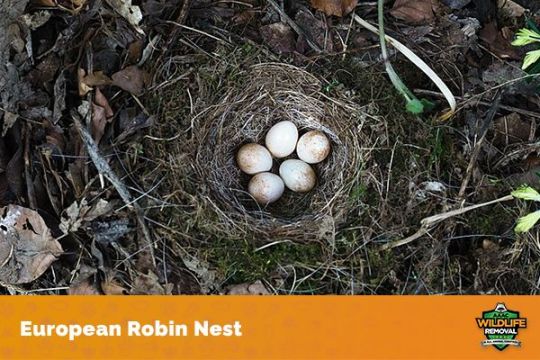
The European Robin
A tiny insectivorous bird also referred to as the robin or the robin redbreast in the British Isles. The male and female are similar in color, measuring around 12.5-14.0 cm in length, with an orange breast and face bordered with grey and brown middle parts and a creamy belly. It is widespread throughout Europe, extends east to Western Siberia, and south to North Africa. They tend not to migrate, but a subset of robins do move around based on the season and latitude of their habitat.
The eggs are cream, or white with reddish-brown spots, which are frequently more prominent at the larger hemisphere of the egg.
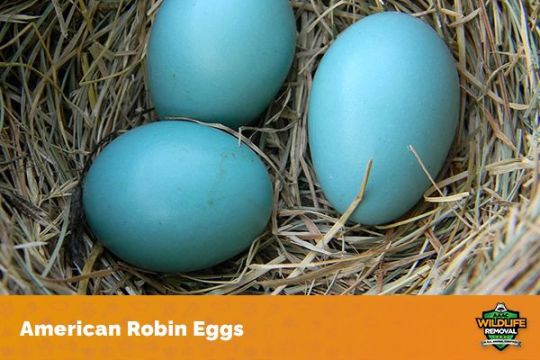
The American robin
A songbird that migrates. Although the two species are not closely related and the European robin is a member of the Old World flycatcher family, it was named after the European robin because of its reddish-orange breast. The American robin can be found all over North America; it winters along the Pacific Coast, in southern Canada, and in central Mexico. It is the national bird of Wisconsin, Michigan, and Connecticut.
The pigment biliverdin is responsible for the blue color of robin eggs when the eggs hatch. There is evidence that the more blue the eggs appear and the healthier the female are associated with elevated biliverdin levels.
Dunnock
The dunnock is a little perching or passerine bird that lives in temperate Europe and Asian Russia. It is also known as the hedge sparrow or hedge accentor. The dunnock is brown above and has a grey breast with two dark streaks. It has a pointed bill and long legs for its size, which is around 15 cm.
A dunnock's egg is pale blue with dark brown spots, and they measure 20 x 15mm and have a matte finish.

Pheasant
Pheasants are a family of birds that includes partridges, quails, francolins, and junglefowls. The pheasant is a gamebird that is native to Asia and has been introduced to Europe, Africa, and North America. It is the national bird of Hungary. The male pheasant is very colorful with a long tail and bare red facial skin. The female is much less colorful and has a shorter tail.
Eggs from pheasants are beautiful. They have a gorgeous pale, olive-green (or occasionally brown) shell and are around half the size of a hen's egg and twice the size of a quail's egg. They have a bright yellow yolk inside.
Canada goose
The Canada goose, often known as the Canadian goose, is a sizable wild bird with a grey body, a black head and neck, white cheeks, and white beneath its chin. In addition to being frequently seen on or near freshwater, the Canada goose is also widespread in saline marshes, estuaries, and lagoons. They are herbivorous and usually migratory.
Each egg measures 2.2 inches in width and 3.3 inches in length (8.3 cm) (5.6 centimeters). The color of the eggs is a creamy white. Goslings are born with their eyes open and coated in a light yellow tint.
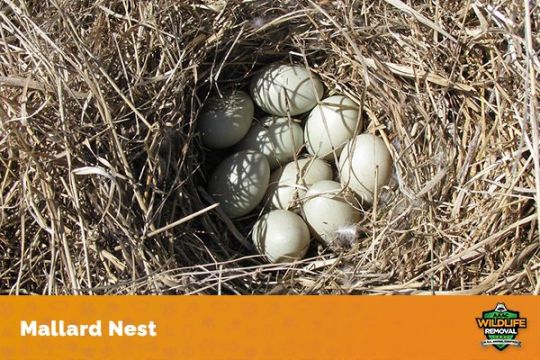
Mallard
The mallard, known as the wild duck, is a dabbling duck that breeds throughout the temperate and subtropical Americas, Eurasia, and North Africa. Males typically have blue speculum feathers, although both sexes have a region of white-bordered black or iridescent blue feathers on their wings. The females (hens) have mostly brown-speckled feathers, while the males have purple spots on their wings.
Eggs laid by mallard ducks can be anything from white to light blue. They can also occasionally be bluish-green. The eggs of a wild mallard are a creamy white color without any markings. Additionally, they appear as a soft blue-green.

Peregrine falcon
The peregrine falcon also called duck hawk in North America, is a black head, barred white underparts, and a massive falcon with a crow-sized body. It is noted for its speed, reaching up to 320 km/h during its distinctive hunting stoop.
The Arctic tundra to the tropics is the peregrine's nesting range. Except for the most severe polar regions, extremely high mountains, and tropical rainforests. New Zealand is the only significant ice-free landmass where it is absent. It makes it one of the most ubiquitous bird species and the most common raptor worldwide.
Typically, a peregrine falcon's female lays 3 to 4 eggs with dark, reddish-brown pigment dotted throughout the eggs, slightly smaller than chicken eggs.

Herring gull
Herring gulls are medium to large seabirds. They are white with grey wings and a yellow bill with a red spot. Adults have light grey legs and feet, and their irises are dark brown. Immature gulls have pale eyes, and their legs and feet are often pinkish.
Adult herring gulls have white bodies, gray wings and backs, black wingtips, and pink legs. Unlike European herring gulls, these birds have darker tails that are gray-brown, darker, and more uniformly colored. It is frequently seen in rubbish dumps, lakes, rivers, and coastal areas. The bird typically builds a nest close to water, laying three or four eggs in a hole dug in the ground. Invertebrates, fish, and various other foods are part of its varied diet.
In shades of olive, green, or brownish-green, gull eggs blend in beautifully. While some species have browner and greener eggs, they all resemble one another. They prefer to blend in well with the mossy or rocky habitats in which they live.
Tawny owl
The tawny owl is a predatory bird of the night. Due to adaptations to its vision, hearing, and ability to fly quietly, it is able to locate and capture prey in the dark. It hunts primarily rodents, birds, and bats by ear and sound location.
The tawny owl has a round head, no ear tufts, and yellow eyes. Its upper parts are streaked brown and its underparts are pale with dark streaks. The facial disc surrounding the eyes is generally pale with a dark border.
The glossy white eggs are 48 x 39 mm in size and weigh 39.0g, which is 7% of the shell.

House martin
The common house martin, also known as the northern house martin or, more commonly, just house martin, is a migratory passerine bird of the swallow family that spends the winters in sub-Saharan Africa and tropical Asia and breeds in Europe, north Africa, and across the Palearctic. It migrates to regions with an abundance of flying insects and feeds on insects that are caught in flight. It can be found in both open areas and close to populated areas. It has a blue head and top parts, a white rump, and all-white underparts.
They hatch four to five soft, pure white eggs, average 1.9 cm by 1.33 cm in size, and weigh 1.7 g.

Great snipe
The great snipe is a wading bird in the sandpiper family. It has a very long bill and is mottled brown above with creamy-buff stripes on its flanks. The underparts are white, sometimes with a brown tinge, and there is a faint stripe over the eye. In flight, it shows a broad white wingbar.
The great snipe has a dark stripe eye and a brown body. The large wings have a light wing bar in flight. North-eastern Europe, especially north-western Russia, has marshes and wet meadows with short vegetation where the great snipe breeds. Great snipes migrate and spend their winters in Africa.
They produce olive-colored eggs with dark brown, black, or purple splotches. With a 1.4-1.7 in length and a 1.0-1.2 in width.
Chicken
The chicken is a type of domesticated jungle fowl that shares characteristics with wild species like the grey and Ceylon junglefowl, which are native to Southeast Asia. A juvenile male bird or a cockerel, and an adult male bird is known as a cock or rooster. A hen is an adult female bird.
A small hen's egg or many eggs are white and brown, but a green or bright blue egg is also possible. The shells of a chicken egg have a smooth and porous surface.
Chough
The choughs, which live in the highlands of southern Eurasia and North Africa, have black plumage with colorful legs, feet, and beaks. They fly spectacularly and have long, broad wings. Both species form lifelong pairs and show loyalty to the caves or cliff wall fissures where they nest. They consume short-grazed grassland in flocks and typically eat mostly invertebrate prey, supplemented by vegetables or food from human settlement, particularly in the winter.
They lay a few large dark speckled, cream-colored eggs. Choughs produce three to five eggs, weighing 15.7g and measuring 39-28 mm.

Cormorant
Cormorants are medium-to-large birds with a body weight of 0.35 to 5 kg and a wing span of 60 to 100 cm include cormorants and shags. Dark feathers are present in the majority of species. Each of their four toes has webbing between them. All species are fish eaters who dive from the surface to get their meal.
They are skilled divers who use their feet to move forward underwater with the assistance of their wings. Some dive as deep as 45 meters. Due to their necessity for efficient underwater movement and relatively short wings, they have one of the most calorically expensive flights of any flying bird.
They lay unmarked pale blue eggs measuring 5.6-7 cm in length and 3.5-4 cm in width.
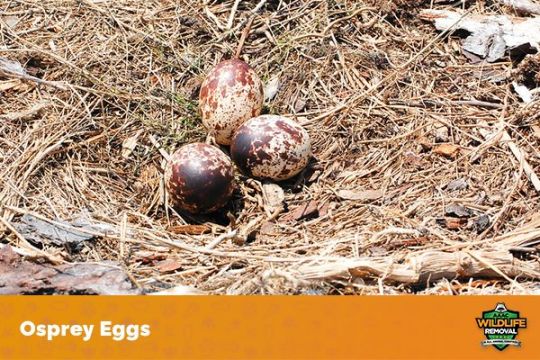
Osprey
The fish-eating, nocturnal osprey, also known as the sea hawk, river hawk, and fish hawk, has a wide geographic range. It is a sizable raptor that can grow to be more than 60 cm long and 180 cm across the wings. The head and underparts are primarily greyish, while the upper parts are brown.
The eggs laid are mottled or speckled with red or dark brown, ranging in color from dirty white to light brown. The eggs are about the size of chicken eggs and weigh 60-80gm each. The first egg is the largest, and the next ones get smaller one or two days later.
Emu
The emu is the second-tallest living big bird after the ostrich. Emus are brown, flightless birds with soft feathers that may grow up to 1.9 meters in height. They also have long necks and legs. Emus go for weeks without eating, although they can travel enormous distances and sprint at 48 km/h when necessary.
Emu lays eggs in an intense green shade with blueish tones. The natural pigment progressively fades with exposure to light, changing the color of the surface to a greyish brown. Emu eggs range in size from 400 to 700 grams and are typically about 13 x 9 cm.

Ostrich
The ratites, including ostritches, emus, rheas, and kiwis, are a diversified group of giant flightless birds.. The common ostrich and the Somali ostrich are the only two species of ostrich that exist today. They are indigenous to Africa. They can run at 70 km/h, making them the quickest birds on land. They are raised worldwide, especially for their feathers which are used as dusters and ornaments. Additionally, their skin is used to make leather goods. The fact that ostriches are the heaviest living birds is noteworthy.
An ostrich egg is a massive, with an egg size measuring 15 cm long, 13 cm wide, and weighing 1.4 kg, on average. The shell is 1-2 mm thick and has a porosity of about 70%. They are spherical and smooth with a glossy surface.
Birds Nesting On Your Gutter or Vent? We'll Remove Them For You!
If you need help with birds and their nesting or other animals on your property, AAAC Wildlife Removal is here to help. We are experts in the field of animal and bird removal, and we can get rid of any problem you may have. We also offer a variety of other services to keep your home or business free of pests. Contact us today to learn more!
Conclusion
Well, that was quite a list! As you can see, many different types of birds and their eggs are as diverse as they are. Some are small and some are large. Some are colorful and some are not. But they all have one thing in common- they are all amazing!
So, the next time you see a bird, take a moment to appreciate all that it is and all that it does. And if you're ever in the market for bird removal services, be sure to give AAAC Wildlife Removal a call! We would be more than happy to help you out!
Locally Published on: https://phoenix.aaacwildliferemoval.com/blog/birds/birds-and-their-eggs/
0 notes
Photo

How many balls of fluff can you count?
These fluffs are actually Laysan duck chicks, endemic to Hawaiʻi and found in Papahānaumokuākea Marine National Monument. Once on the brink of extinction (with only 11 individuals left), these ducks are considered one of the most critically endangered waterfowl. Now, thanks to conservation efforts, there is a recovering population on their native Laysan Island and a relocated population living on Midway Atoll National Wildlife Refuge.
Photo: Naomi Worchester/Hawaiʻi DLNR. Image description: A brown adult Laysan duck with white feathers around the eyes leading a row of fluffy brown chicks through a field.)
76 notes
·
View notes
Text
Discovering Fascinating Animals That Start with "Y"
When it comes to the animal kingdom, our planet is home to an incredible variety of species, each with its unique characteristics and adaptations. From the mighty lion to the graceful dolphin, the world never ceases to amaze us with its diverse array of creatures. In this article, we will delve into the lesser-known but equally intriguing realm of animals that start with Y. Prepare to be captivated by these remarkable beings that may have slipped under your radar until now.
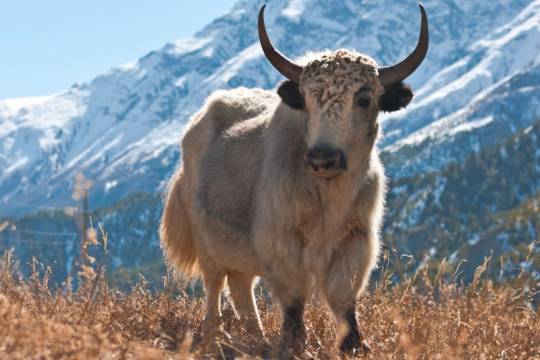
1. Yellow-Eyed Penguin:
The Yellow-Eyed Penguin, scientifically known as Megadyptes antipodes, is a species of penguin endemic to New Zealand. With striking yellow eyes that stand out against their black and white plumage, these penguins are a sight to behold. Unfortunately, they are considered one of the rarest penguin species, facing threats such as habitat loss and human disturbance.
2. Yellow-Billed Hornbill:
Native to sub-Saharan Africa, the Yellow-Billed Hornbill (Tockus leucomelas) is a vibrant bird species with a distinct yellow bill and a black and white plumage. These fascinating creatures are known for their unique nesting habits, as they seal themselves inside tree cavities using a mixture of mud, droppings, and fruit pulp, leaving only a narrow slit through which they are fed by their mates.
3. Yellow Tang:
The Yellow Tang (Zebrasoma flavescens) is a popular aquarium fish found in the waters of the Pacific Ocean, particularly around Hawaii. Sporting a bright yellow body and a vibrant blue tail, these tropical fish are sought after for their striking appearance. However, it's important to ensure their acquisition is from sustainable sources, as overharvesting can harm their populations.
4. Yellow Mongoose:
Residing in the grasslands and savannas of southern Africa, the Yellow Mongoose (Cynictis penicillata) is a small carnivorous mammal known for its yellowish-brown fur. These highly social creatures live in burrows and have a diverse diet that includes insects, rodents, eggs, and even small reptiles. Their keen sense of smell and agility make them skilled hunters in their natural habitat.
Conclusion:
The animal kingdom never fails to astonish us with its wonders, and the world of creatures beginning with the letter "Y" is no exception. From the adorable Yellow-Eyed Penguin to the charismatic Yellow-Billed Hornbill, and the vibrant Yellow Tang to the resourceful Yellow Mongoose, these animals offer a glimpse into the extraordinary diversity found on our planet. By learning about and appreciating these often-overlooked species, we can deepen our understanding of the natural world and work towards its conservation. So, let's continue to explore and protect these fascinating animals that start with "Y" and ensure their survival for generations to come.
0 notes